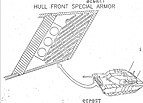M1 Abrams
| M1 Abrams | |
|---|---|
 U.S. Army M1A2 Abrams with production TUSK explosive reactive armor package installed in Iraq, 2008 | |
| Type | Main battle tank |
| Place of origin | United States |
| Service history | |
| In service | 1980–present |
| Used by | See Operators below |
| Wars | |
| Production history | |
| Designer | Chrysler Defense (now General Dynamics Land Systems) |
| Designed | 1972–1975 |
| Manufacturer | Lima Army Tank Plant (since 1980)[1] Detroit Arsenal Tank Plant (1978, 1982–1991) Egyptian Defense Company Tank Plant[2] |
| Unit cost | M1A1: $4.3 million (domestic cost, FY1989) (~$10.66 million, FY2023)[3] M1A2 SEP v3: $24 million (export cost, FY2022)[4] |
| Produced | 1979–Present |
| No. built | approx. 10,300 as of 2017[5] |
| Variants | See variants |
| Specifications | |
| Mass | M1: 60 short tons (54 t)[6] M1A1: 63 short tons (57 t)[6] M1A1 SA: 67.6 short tons (61.3 t) M1A2 SEP v2: 71.2 short tons (64.6 t) M1A2 SEP v3: 73.6 short tons (66.8 t)[7] |
| Length | Gun forward: 32.04 ft (9.77 m)[8] Hull length: 26.02 ft (7.93 m) |
| Width | 12 ft (3.66 m)[8] |
| Height | 8 ft (2.44 m)[8] |
| Crew | 4 (commander, gunner, loader, driver) |
| Elevation | +20° / -10°[6] |
| Traverse | 9 seconds/360 degrees[6] |
| Armor | Composite armor |
Main armament | M1: 105 mm L/52 M68A1 rifled gun (55 rounds) M1A1: 120 mm L/44 M256 smoothbore gun (40 rounds) M1A2: 120 mm L/44 M256 smoothbore gun (42 rounds) |
Secondary armament | 1 × 0.50 caliber (12.7 mm) M2HB heavy machine gun with 900 rounds 2 × 7.62 mm (.308 in) M240 machine guns with 10,400 rounds (1 pintle-mounted, 1 coaxial) |
| Engine | Honeywell AGT1500 multi-fuel turbine engine 1,500 shp (1,120 kW) |
| Power/weight | From 26.9 hp/t (20.05 kW/t) to 23.8 hp/t (17.74 kW/t) |
| Transmission | Allison DDA X-1100-3B |
| Suspension | High-hardness-steel torsion bars with rotary shock absorbers |
| Ground clearance | M1, M1A1: 0.48 m (1.6 ft; 19 in) M1A2: 0.43 m (1 ft 5 in) |
| Fuel capacity | 504.4 US gallons (1,909 L) |
Operational range | M1A2, road: 265 mi (426 km) Cross country: 93–124 mi (150–200 km)[9] |
| Maximum speed | M1A1, road: 45 mph (72 km/h) (governed); M1A2, road: 42 mph (67 km/h) (governed); Off-road: 25 mph (40 km/h)[9] |
The M1 Abrams (/ˈeɪbrəmz/)[10] is a third-generation American main battle tank designed by Chrysler Defense (now General Dynamics Land Systems) and named for General Creighton Abrams. Conceived for modern armored ground warfare and now one of the heaviest tanks in service at nearly 73.6 short tons (66.8 metric tons). It introduced several modern technologies to United States armored forces, including a multifuel turbine engine, sophisticated Chobham composite armor, a computer fire control system, separate ammunition storage in a blowout compartment, and NBC protection for crew safety. Initial models of the M1 were armed with a 105 mm M68 gun, while later variants feature a license-produced Rheinmetall 120 mm L/44 designated M256.
The M1 Abrams was developed from the failed joint American-West German MBT-70 project that intended to replace the obsolete M60 tank. There are three main operational Abrams versions, the M1, M1A1, and M1A2, with each new iteration seeing improvements in armament, protection, and electronics.[11]
The Abrams was to be replaced in U.S. Army service by the XM1202 Mounted Combat System, but since that project was canceled, the Army has opted to continue maintaining and operating the M1 series for the foreseeable future by upgrading with improved optics, armor, and firepower.
The M1 Abrams entered service in 1980 and serves as the main battle tank of the United States Army and formerly of the United States Marine Corps (USMC) until the decommissioning of all USMC tank battalions in 2021. The export modification is used by the armed forces of Egypt, Kuwait, Saudi Arabia, Australia, Poland and Iraq. The Abrams was first used in combat by the U.S. in the Gulf War and later, both the War in Afghanistan and the Iraq War, while other countries deploying Abrams tanks have been Iraq in the war against the Islamic State and Saudi Arabia in the Yemeni Civil War.
History
Previous developments
Through the 1960s, the U.S. Army and Bundeswehr had collaborated on a single design that would replace both the M60 tank and the Leopard 1. The overall goal was to have a single new design with improved firepower to handle new Soviet tanks like the T-62, while providing improved protection against the T-62's new 115 mm smoothbore gun and especially high-explosive anti-tank (HEAT) rounds.[citation needed]
The resulting design, the MBT-70, incorporated new technologies across the board. A hydropneumatic suspension provided improved cross-country ride quality and also allowed the entire tank to be raised or lowered by the driver. The newer 1,500 hp (1,100 kW) Avco-Lycoming AGT1500 engine powered the designs which could both reach 43 miles per hour (69 km/h). The American version used a 152 mm gun whose primary long-range weapon was the Shillelagh missile.[citation needed]
While the design was highly capable, its weight continued to grow, as did its budget. By 1969, the unit cost stood at five times the original estimates, causing the Department of Defense to suspend the program.[12] Development of the tank continued on an austere basis until January 1970, when the DoD and Germany ended their partnership.[13]
The U.S. Army began work on an austere version of the MBT-70, named XM803. The Army's changes were insufficient to allay concerns about the tank's cost.[14] Congress canceled the XM803 in December 1971 but permitted the Army to reallocate remaining funds to develop a new main battle tank.[15]
Starting afresh
The Army began the XM815 project in January 1972. The Main Battle Tank Task Force (MBTTF) was established under Major General William Desobry. The task force prepared design studies with the technical support of Tank-automotive and Armaments Command (TACOM).[16] TACOM began examining specific goals. To this end, a new design basis emerged in February 1973. It had to defeat any hit from a Soviet gun within 800 m (2,600 ft) and 30 degrees to either side. The tank would be armed with the 105 mm M68 gun, a licensed version of the Royal Ordnance L7, and a 20 mm version of the M242 Bushmaster.[17] The Army later deleted the latter from the design, seeing it as superfluous.[18]
In spring 1972, Desobry was briefed by the British on their own newly developed "Burlington" armor from the British Army's labs. The armor performed exceptionally against shaped charges such as HEAT rounds. In September, Desobry convinced the Army to incorporate the new armor. To take full advantage of Burlington, also known as Chobham, the new tank would have to have armor around two feet thick (for comparison, the armor on the M60 is around four inches thick). General Creighton Abrams set the weight of the new tank at 58 short tons (53 t). The original goal of keeping weight under 50 short tons (45 t) was abandoned.[19]
At the time, the Pentagon's procurement system was beset with problems being caused by the desire to have the best possible design. This often resulted in programs being canceled due to cost overruns, leaving the forces with outdated systems, as was the case with the MBT-70. There was a strong movement within the Army to get a new design within budget to prevent the MBT-70 experience from repeating itself. For the new design, the Army set the design-to-unit cost at no more than $507,790 (equivalent to $3,699,000 in 2023).[20]
The Pentagon's approach to control of research and development was modified with the XM1. Previous acquisition strategy called for a significant amount of the design work to be done by the government. Under the new framework, contractors would competitively bid their own designs rather than compete solely for the right to manufacture the end product.[21]
In January 1973, the U.S. Army issued the XM1 (as the XM815 had been renamed in November 1972) request for proposals.[22]
In May 1973, Chrysler Defense and General Motors submitted proposals. Both were armed with the 105 mm M68 gun, the licensed L7, and the 20 mm Bushmaster. Chrysler chose a 1,500 hp Lycoming AGT1500 gas turbine engine. GM's model was powered by a 1,500 hp diesel engine similar to that used on the American MBT-70 and XM803.[23]
Prototypes

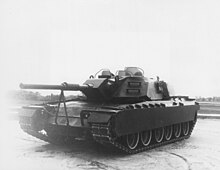
Prototypes were delivered in 1976 by Chrysler and GM armed with the M68E1 105 mm gun. They entered head-to-head testing at Aberdeen Proving Ground.[24][24] The testing showed that the GM design was generally superior to Chrysler's, offering better armor protection, and better fire control and turret stabilization systems.[20]
During testing, the power packs of both designs proved to have issues. The Chrysler gas turbine engine had extensive heat recovery systems in an attempt to improve its fuel efficiency to something similar to a traditional internal combustion engine. This proved not to be the case: the engine consumed much more fuel than expected, burning 3.8 US gallons per mile (890 L/100 km). The GM design used a new variable-compression diesel design.[20]
By spring 1976, the decision to choose the GM design was largely complete. In addition to offering better overall performance, there were concerns about Chrysler's engine both from a reliability and fuel consumption standpoint. The GM program was also slightly cheaper overall at $208 million compared to $221 million for Chrysler. In July 1976, the Army prepared to inform Congress of the decision to move ahead with the GM design. All that was required was the final sign-off by the U.S Secretary of Defense, Donald Rumsfeld.[20]
Back to the drawing board
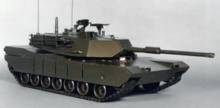
On 20 July 1976, United States Secretary of the Army Martin Hoffmann and a group of generals visited Deputy Defense Secretary Bill Clements and Director of Defense Research and Engineering Malcolm Currie on their decision. They were surprised when Clements and Currie criticized their decision and demanded the turbine be selected. Donald Rumsfeld heard arguments from both in the afternoon. The Army team spent the night writing briefs and presented them to Rumsfeld the next morning, who then announced a four-month delay.[20]
Within days, GM was asked to present a new design with a turbine engine. According to Assistant Secretary for Research and Development Ed Miller, "It became increasingly clear that the only solution which would be acceptable to Clements and Currie was the turbine... It was a political decision that was reached, and for all intents and purposes that decision gave the award to Chrysler since they were the only contractor with a gas turbine."[20]
In the meantime, in September 1976 three West German Leopard 2 AV prototypes were belatedly sent to Aberdeen for comparison testing.[25] Germany had signed a somewhat vague memorandum of understanding in 1974 committing both parties toward commonality in tank parts. Germany had assumed that its tank would be evaluated against the GM and Chrysler's prototypes and that the best tank would be chosen for production. This misunderstanding arose from the fact that in public statements both countries had overrepresented the MOU as an agreement that both countries select a common MBT. In reality, the U.S. Army was unwilling to choose a foreign tank unless it was obviously superior in design and cost.[26] In any case, the Leopard 2 was found to meet U.S. requirements but was thought to cost more.[24] The U.S. Army announced in January 1977 that Germany had withdrawn the tank from consideration.[27]
Chrysler is chosen
On 12 November 1976, the Defense Department awarded a $20 billion development contract to Chrysler.[20]
The turbine engine does not appear to be the only reason for this decision. Chrysler was the only company that appeared to be seriously interested in tank development; the M60 had been lucrative for the company. In contrast, GM made only about 1% of its income from military sales, compared to 5% for Chrysler, and only submitted their bid after a "special plea" from the Pentagon.[20]
Having narrowly averted losing the contract, Chrysler set about improving the design. Expensive components were replaced with less expensive ones. Chrysler's team also negotiated lower costs from their subcontractors. The price of the redesigned tank's turret especially was decreased, but other improvements came from unexpected places such as a $600 hydraulic oil reservoir replaced with a $25 one.[28] Chrysler also submitted a version with a Teledyne AVCR-1360 diesel engine.[29] Chrysler's new bid came to $196 million, down from $221 million in the original proposal.[28]

GM's proposal replaced the diesel engine with an AGT1500 turbine and integrated a turret capable of mounting either the 105 mm or 120 mm gun.[29] Cost growth pushed the tank bid to $232 million from $208 million.[28]
Although the GM team had successfully integrated the turbine, Baer was more impressed by the cost savings introduced by the Chrysler team's redesign.[28] On 12 November 1976, the Defense Department awarded the $4.9 billion development contract to Chrysler.[30]
Eleven preproduction models were manufactured between February and July 1978 at Detroit Arsenal Tank Plant.[31]
Quality problems with the engine quickly became apparent. The first preproduction units that arrived at Aberdeen Proving Ground in March 1978 had serious problems. The tank accumulated mud under the hull which led to thrown tracks. This was resolved by Chrysler, who installed a scraper. This did not solve the issue entirely. It was determined months later that the track tension gauge was miscalibrated. This caused the tracks to be fitted too loosely.[32]
Another problem was the ingestion of debris by the engine. It was eventually determined that workers had removed metal around the engine air inlet to make the engine fit on each of the 11 preproduction models. This allowed air carrying dust and other debris to go around the filter. Additionally, the air filters left a half-inch gap on each side of the seal.[32]
At Fort Bliss, several tanks experienced transmission issues. It was determined that the soldiers at Fort Bliss had discovered that they could throw the vehicle from acceleration into reverse, a tactically advantageous maneuver called the "bow tie". Chrysler installed a device that prevented this.[32]
Production starts
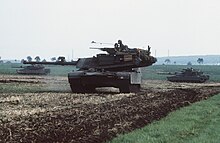
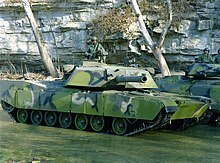
Low rate initial production (LRIP) of the vehicle was approved on 7 May 1979.[17] In February 1982, General Dynamics Land Systems Division (GDLS) purchased Chrysler Defense, after Chrysler built over 1,000 M1s.[33]
A total of 3,273 M1 Abrams tanks were produced during 1979–1985 and first entered U.S. Army service in 1980. Production at the government-owned, GDLS-operated Lima Army Tank Plant in Lima, Ohio, was joined by vehicles built at the Detroit Arsenal Tank Plant (DATP) in Warren, Michigan from 1982 to 1991 (DATP also produced the 11 preproduction models in 1978.[31]).[34][35] The U.S. Army Laboratory Command (LABCOM), under the supervision of the United States Army Research Laboratory (ARL), was also heavily involved with designing the tank with M1A1 armor resistant shells, M829A2 armor-penetrating rounds, and improved weapon range.[36]
The M1 was armed with the license-built M68A1 version of the 105 mm Royal Ordnance L7 gun. The tank featured the first-of-its-kind Chobham armor. The M1 Abrams was the first to use this advanced armor. It consisted of an arrangement of metal and ceramic plates.[37] An improved model called the IPM1 was produced briefly in 1984 and contained upgrades to armor and other small improvements.
120 mm gun M1A1
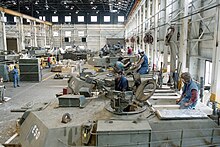
A number of considerations had led the service and its contractors to favor the Army's standard M68 105 mm gun over Germany's 120 mm Rheinmetall Rh-120 smoothbore gun for the XM1. To begin with, the 105 mm gun was "the smallest, lightest, and least costly gun adequate for the job."[38] Indeed, new kinetic energy ammunition for the weapon then under development by the Army promised to extend the gun's usefulness well into the future. And because the Army's other tanks, the M60 and the upgraded M48, as well as the tanks of virtually every other NATO nation, used the 105 mm gun, mounting that gun on the XM1 promised to increase standardization within the alliance. Moreover, the continuing development of the new ammunition for the XM1 automatically upgraded every other gun in NATO. For all of these reasons, the XM1's development proceeded "on the assumption that the 105 mm gun would probably be the eventual main armament."[38][39] The tripartite British—American—German gun trials of 1975 produced a general agreement in the U.S. Defense Department that at some future point, a 120 mm gun of some design would be added to the XM1. Apparently anticipating this, Chrysler and GM had both made changes to their tanks during development to make them compatible with a variety of main guns.[40] In January 1978, the Secretary of the Army announced that the Rheinmetall 120 mm gun would be mounted on future production versions of the XM1. This decision established the requirement for a separate program for the M1E1 (with 120 mm gun) so that the XM1 program could continue unimpeded.[41]
About 5,000 M1A1 Abrams tanks were produced from 1986 to 1992 and featured the M256 120 mm smoothbore cannon, improved armor, consisting of depleted uranium and other classified materials, and a CBRN protection system. Production of M1 and M1A1 tanks totaled some 9,000 tanks at a cost of approximately $4.3 million per unit.[3]
In 1990, a Project On Government Oversight report criticized the M1's high costs and low fuel efficiency in comparison with other tanks of similar power and effectiveness such as the Leopard 2.[3]
As the Abrams entered service, they operated alongside M60A3 within the U.S. military and with other NATO tanks in various Cold War exercises which usually took place in Western Europe, especially West Germany. The exercises were aimed at countering Soviet forces.[citation needed]
Adaptations before the Gulf War (Operations Desert Shield and Desert Storm) gave the vehicle better firepower and NBC (Nuclear, Biological and Chemical) protection.[42]
Gulf War
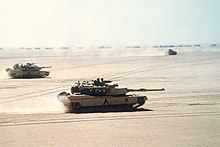
The Abrams remained untested in combat until the Gulf War in 1991, during Operation Desert Storm. The first Abrams tanks to arrive in Saudi Arabia in August 1990 in the buildup to the war were M1 and IPM1 tanks with 105 mm guns.[43] All but two battalions of 105 mm gun Abrams tanks were replaced by M1A1 tanks prior to the American invasion in January 1991.[44] The U.S. Army deployed a total of 1,956 M1A1s (733 M1A1, 1,233 M1A1HA) to Saudi Arabia to participate in the liberation of Kuwait.[45] The U.S. Marine Corps deployed 353 tanks, of which 277 were M60s and 76 were M1A1 (60 M1A1HA and 16 M1A1 Common). The M1A1 Common variant included adaptations for deep wading and improvements to increase commonality with the Army's Abrams. The 2nd Tank Battalion was equipped with M1A1HA Abrams borrowed from the Army.[43]
The M1A1 was superior to Iraq's Soviet-era T-54/T-55 and T-62 tanks, as well as T-72 versions imported from the Soviet Union and Poland.[46] Polish officials stated that no license-produced T-72 (nicknamed Lion of Babylon) tanks were finished before destruction of the Iraqi Taji tank plant in 1991.[46]
Iraq's T-72s, like most Soviet export designs, lacked night-vision systems and then-modern rangefinders, though they did have some night-fighting tanks with older active infrared systems or floodlights. Very few M1 tanks were hit by enemy fire and none were destroyed as a direct result of enemy fire, none of which resulted in any fatalities.[42] Three Abrams were left behind the enemy lines after a swift attack on Talil airfield, south of Nasiriyah, on February 27. One of them was hit by enemy fire, the two other embedded in mud. The tanks were destroyed by U.S. forces to prevent any trophy-claim by the Iraqi Army.[47] A total of 23 M1A1s were damaged or destroyed during the war. Of the nine Abrams tanks destroyed, seven were destroyed by friendly fire and two intentionally destroyed to prevent capture by the Iraqi Army. No M1s were lost to enemy tank fire.[48] Some others took minor combat damage, with little effect on their operational readiness.[49]
The M1A1 could kill other tanks at ranges in excess of 8,200 feet (2,500 m). This range was crucial in combat against previous generation tanks of Soviet design in Desert Storm, as the effective range of the main gun in the Iraqi tanks was less than 6,600 feet (2,000 m). This meant Abrams tanks could hit Iraqi tanks before the enemy got in range—a decisive advantage in this kind of combat. In friendly fire incidents, the front armor and fore side turret armor survived direct APFSDS hits from other M1A1s. This was not the case for the side armor of the hull and the rear armor of the turret, as both areas were penetrated on at least two occasions by unintentional strikes by depleted uranium ammunition during the Battle of Norfolk.[50]

Lessons from the war improved the tank's weapons sights and fire control unit.
Waco siege

During the Waco siege in 1993, two M1A1 Abrams tanks were borrowed from the military[51] and deployed by the FBI against the Branch Davidians.[52]
Upgrades
The M1A2 was a further improvement of the M1A1, with a commander's independent thermal viewer, weapon station, position navigation equipment, and a full set of controls and displays linked by a digital data bus. These upgrades also provided the M1A2 with an improved fire control system.[53] The M1A2 System Enhancement Package (SEP) added digital maps, Force XXI Battle Command Brigade and Below (FBCB2) Linux communications system capabilities for commanders, and an improved cooling system to compensate for heat generated by the additional computer systems.[54]
The M1A2 SEP also serves as the basis for the M104 Wolverine heavy assault bridge. The M1A2 SEPv2 (version 2) added Common Remotely Operated Weapon Station (CROWS or CROWS II) support, color displays, better interfaces, a new operating system, better front and side armor, and an upgraded transmission for better durability.[54]
Further upgrades included depleted uranium armor for all variants, a system overhaul that returns all A1s to like-new condition (M1A1 AIM), a digital enhancement package for the A1 (M1A1D), and a commonality program to standardize parts between the U.S. Army and the Marine Corps (M1A1HC). Improvements to survivability, lethality, and protection have been sought since 2014.[55]
Iraq War
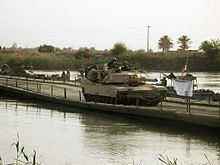

Further combat was seen during 2003 when U.S. forces invaded Iraq and deposed Iraqi President Saddam Hussein in the Iraq War's Operation Iraqi Freedom. One achievement of the M1A1s was the destruction of seven T-72s in a point-blank skirmish (less than 50 yards (46 m)) near Mahmoudiyah, about 18 miles (29 km) south of Baghdad, with no U.S. losses.[56] This was in the face of inadequately trained Iraqi tank crews, most of whom had not fired live ammunition in the previous year due to the sanctions then in operation and made no hits at point-blank range.[57]
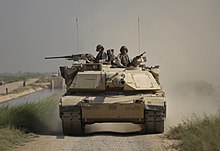
Following lessons learned in Desert Storm, the Abrams and many other U.S. combat vehicles used in the conflict were fitted with Combat Identification Panels to reduce friendly fire incidents.[58]
Several Abrams tanks that were irrecoverable due to loss of mobility or other circumstances were destroyed by friendly forces, usually by other Abrams tanks, to prevent their capture.[59] Some Abrams tanks were disabled by Iraqi infantrymen in ambushes during the invasion. Some troops employed short-range anti-tank rockets and fired at the tracks, rear and top. Other tanks were put out of action by engine fires when flammable fuel stored externally in turret racks was hit by small arms fire and spilled into the engine compartment.[60][61] By March 2005, approximately 80 Abrams tanks had been forced out of action by enemy attacks;[62] 63 were shipped back to the U.S. for repairs, while 17 were damaged beyond repair[63] with 3 of them at the beginning of 2003.[64]

Vulnerabilities exposed during urban combat in the Iraq War were addressed with the Tank Urban Survival Kit (TUSK) modifications, including armor upgrades and a gun shield, issued to some M1 Abrams tanks. It added protection in the rear and side of the tank and improved fighting ability and survival ability in urban environments.[66] By December 2006 more than 530 Abrams tanks had been shipped back to the U.S. for repairs.[67]
In May 2008, it was reported that a U.S. M1 tank had also been damaged in Iraq by insurgent fire of a Soviet-made RPG-29 "Vampir", which uses a tandem-charge HEAT warhead to penetrate explosive reactive armor (ERA) as well as composite armor behind it.[68] The U.S. considered the RPG-29 a high threat to armor and refused to allow the newly formed Iraqi Army to buy it, fearing that it would fall into the insurgents' hands.[69]
Iraqi Army service
Between 2010 and 2012 the U.S. supplied 140 refurbished M1A1 Abrams tanks to Iraq. In mid-2014, they saw action when the Islamic State of Iraq and the Levant launched the June 2014 Northern Iraq offensive. During three months, about one-third of the Iraqi Army's M1 tanks had been damaged or destroyed by ISIL and some were captured by opposing forces. By December 2014, the Iraqi Army only had about 40 operational Abrams left. That month, the U.S. Department of State approved the sale of another 175 Abrams to Iraq.[70][71][72]
Iranian-backed Iraqi Shiite Kata'ib Hezbollah (Hezbollah Brigades) were reported to operate M1 Abrams, and released publicity showing the tanks being transported by trucks to take part in the Battle of Mosul. It is not known whether the tanks were captured from ISIL, seized from Iraq's military, or handed over.[73]
One Iraqi-operated Abrams has been nicknamed "The Beast" after it became the lone working tank when taking back the town of Hit in April 2016, destroying enemy fighting positions and IED emplacements.[74]
In October 2017, Abrams were used by the Iraqi security forces and the Popular Mobilization Forces (also called Al-Hashd al-Shaabi) in assaults against the Kurdistan Regional Government Peshmerga in the town of Altun Kupri (also called Prde). It was claimed by Kurdish commanders that at least one Abrams was destroyed by the Peshmerga.[75]
War in Afghanistan
Canada and Denmark deployed Leopard 1 and 2 MBTs that were specially modified to operate in the relatively flat and arid conditions of southwestern Afghanistan. In late 2010, at the request of Regional Command Southwest, the U.S. Marine Corps deployed a small detachment of 14 M1A1 Abrams tanks from Delta Company, 1st Tank Battalion, 1st Marine Division (Forward),[76] to southern Afghanistan in support of operations in Helmand and Kandahar provinces.[77]
2015 Yemen Civil War
Saudi Abrams tanks saw service in the 2015 Yemeni Civil War, where M1A2s were used against Houthi rebels.[78] In August 2016, the U.S. approved a deal to sell up to 153 more Abrams tanks to Saudi Arabia, including 20 "battle damage replacements", suggesting that some Saudi Arabian Abrams had been destroyed or severely damaged in combat in Yemen.[79][80]
Russo-Ukrainian War
Russian invasion of Ukraine
On 24 January 2023, U.S. President Joe Biden said that the United States would send 31 M1 Abrams tanks to Ukraine,[81] stating that this was intended to "enhance Ukraine's capacity to defend its territory and achieve its strategic objectives" and was "not an offensive threat to Russia."[82] The plan to transfer the tanks to Ukraine was approved as part of a larger support package.[83] Pentagon spokesperson Sabrina Singh specified that the tanks would be the M1A2 variant; however, because they were not available in excess in U.S. stocks, they would be purchased through Ukraine Security Assistance Initiative (USAI) and could take up to two years to manufacture and deliver. She also acknowledged the challenges of training Ukrainian tank crews and maintaining the tanks in Ukraine.[84] In March 2023 the Pentagon announced that, in order to expedite delivery, older M1A1 variants would be pulled from Army stocks and refurbished for delivery by the fall. This change would also ensure deliveries to US allies of new M1A2s would not be disrupted.[85]
On 25 September 2023, Ukrainian President Volodymyr Zelenskyy announced the arrival of the first batch out of 31 M1 Abrams tanks promised by the United States to Ukraine, without specifying its number, although Politico reported the number to be ten. These machines are former U.S. Marine Corps tanks, of the initial batch of 31, expected to be sent "during the fall". More Abrams are also expected in coming months.[86][87][88] The first pictures of the M1A1 in Ukrainian usage appeared online in November 2023, showing a M1A1 near Kupiansk.[89][90]
On 26 February 2024, an M1A1 was reported as lost in Ukraine. The blowout panels on the ammo bins had been activated, indicating that the ammunition had cooked off. It is unknown if Ukrainian or Russian forces are able to recover it.[91][92] This M1A1 was destroyed by a FPV Piranha 10 quadrone, which is capable of delivering the RPG-7 warhead.[93] As of late March 2024, four M1 tanks have been visually confirmed as destroyed near Avdiivka according to Oryx.[94]
Proposed production shutdown
Serial production of the M1 Abrams for the U.S. Army ended in 1995, though production for exports continued until 2000.[35]
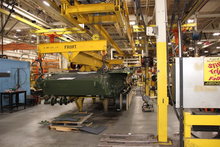
The U.S. Army planned to end operations at Joint Systems Manufacturing Center (formerly Lima Army Tank Plant)[95] from 2013 to 2016 to save over $1 billion; it would be restarted in 2017 to upgrade existing tanks. General Dynamics Land Systems (GDLS), which operates the factory, opposed the move, arguing that suspension of operations would increase long-term costs and reduce flexibility.[96][97] Specifically, GDLS estimated that closing the plant would cost $380 million and restarting production would cost $1.3 billion.[98]
By August 2013, Congress had allocated $181 million for buying parts and upgrading Abrams systems to mitigate industrial base risks and sustain development and production capability. Congress and General Dynamics were criticized for redirecting money to keep production lines open and accused of "forcing the Army to buy tanks it didn't need." General Dynamics asserted that a four-year shutdown would cost $1.1–1.6 billion to reopen the line, depending on the length of the shutdown, whether machinery would be kept operating, and whether the plant's components would be completely removed.[95]
They contended that the move was to upgrade Army National Guard units to expand a "pure fleet" and maintain production of identified "irreplaceable" subcomponents. A prolonged shutdown could cause their makers to lose their ability to produce them and foreign tank sales were not guaranteed to keep production lines open. There is still a risk of production gaps even with production extended through 2015. With funds awarded before recapitalization is needed, budgetary pressures may push planned new upgrades for the Abrams from 2017 to 2019.[95]
In December 2014, Congress again allocated $120 million, against the wishes of the Army, for Abrams upgrades.[99]
In late 2016, tank production and refurbishment had fallen to a rate of one per month with fewer than 100 workers on site. In 2017, the Trump administration ordered military production to increase, including Abrams production and employment. In 2018, it was reported that the Army had ordered 135 tanks rebuilt to new standards, with employment at over 500 workers and expected to rise to 1,000.[100]
Future plans
During the 1980s and 1990s, the Block III main battle tank from the Armored Systems Modernization (ASM) program was expected to succeed the M1 Abrams family in the 1990s. The design had an unmanned turret with a 140 mm main gun, as well as improved protection. The end of Cold War hostilities caused the end of the program. The tracked M8 Armored Gun System was conceived as a possible supplement for the Abrams in U.S. service for low-intensity conflict in the early 1990s. Prototypes were made but the program was canceled. The eight-wheeled M1128 Mobile Gun System was designed to supplement the Abrams in U.S. service for low-intensity conflicts.[101] It has been introduced into service and serves with Stryker brigades.
The Future Combat Systems XM1202 Mounted Combat System was to replace the Abrams in U.S. Army service and was in development when funding for the program was canceled in 2010.[102]
Engineering Change Proposal 1 is a two-part upgrade process. ECP1A adds space, weight, and power improvements and active protection against improvised explosive devices. Nine ECP1A prototypes have been produced as of October 2014. ECP1B, which would begin development in 2015, may include sensor upgrades and converging several tank round capabilities into a multi-purpose round.[103]
As of 2021, the Army anticipated that the remaining M1A2 to beyond 2050.[104] As of 2021 the Army will begin divesting its M1A1 SA variants in fiscal year 2025.[105]
The Marine Corps pursued a force restructuring plan named Force Design 2030. Under this program, all U.S. Marine tank battalions were deactivated and their M1A1 tanks transferred to the Army by the end of 2021.[106][107]
As of 2021, the U.S. Army was evaluating a replacement for the M1 Abrams as part of the Next Generation Combat Vehicle (NGCV) program, notionally known as the Decisive Lethality Platform (DLP).[108]
In September 2023, the U.S. Army announced that it had canceled the planned M1A2 SEPv4 variant and would instead redirect resources into a new variant of the Abrams tank, named M1E3.[109]
Design
Countermeasures
Camouflage


Some XM1 FSED pilot vehicles and XM1 LRIP tanks were painted with the Mobility Equipment Research and Design Command (MERDC) 4-color paint scheme.[110] Factory-applied forest green paint gave way to "Europe 1", a three-color pattern, in 1983 at the same time as Chemical Agent Resistant Coating (CARC) was adopted. Europe 1 consisted of Green 383, Brown 383, and black colors.[111]
U.S Army Abrams deployed to the Iraq War were painted Carc Tan 686A.[112] Due to the increasing significance of American operations in Europe, the U.S. Army transitioned most of its vehicles to CARC Green 383 starting around 2017.[113]
M1A1s came from the factory with the NATO three color camouflage Black/Med-Green/Dark-Brown CARC paint jobs.[citation needed] Today, M1A1s are given the NATO three color paint job during rebuilds. M1s and M1A1s deployed to Operation Desert Storm were hastily painted desert tan. Some, but not all, of these tanks were repainted to their "authorized" paint scheme. M1A2s built for Middle Eastern countries were painted in desert tan. Replacement parts (roadwheels, armor skirt panels, drive sprockets, etc.) are painted olive green, which can sometimes lead to vehicles with a patchwork of green and desert tan parts.
Australian M1A1s are camouflaged in AUSCAM, a scheme that consists of black, olive drab, and brown.[114]
Concealment
The turret is fitted with two six-barreled M250 smoke grenade launchers (USMC M1A1s used an eight-barreled version), with one on each side. When deployed, the grenades airburst, creating a thick smoke that blocks both visual and thermal imaging. The engine is also equipped with a vehicle engine exhaust smoke system (VEESS) that is triggered by the driver. When activated, fuel is sprayed into the hot turbine exhaust, creating thick smoke. This system was discontinued by the U.S. Army after it switched to JP-8 jet fuel in the 1990s[115] due to the risk of fire.[citation needed]
Armor


In addition to conventional rolled homogeneous armor (RHA), the Abrams uses a secret British-developed composite armor called Chobham.
The M1 Abrams composite armor (referred to as "special armor" by the U.S. Army)[116] is most substantial at the front of the hull, where it is 2 feet (0.61 m) at its thickest.[37] The front of the hull is the only part of the hull armored with composites other than the side skirts of the frontal half of the hull. The Abrams turret features composite armor across both the front and the sides.[117]
The armor is much thicker on the Abrams than on previous tanks. This is not a reflection of any weakness of Chobham armor—pound-for-pound Chobham is better at stopping shaped charges and kinetic projectiles. Rather, unlike RHA, Chobham is optimized against shaped charge projectiles. Effective shaped charges, particularly anti-tank guided missiles, were a relatively new battlefield innovation. Lacking a breakthrough advance in novel armor material to negate shaped charges, previous tank designers had simply not found it practical to add the amount of RHA required to defeat shaped charges.[118]
While the exact composition of the Abrams' composite armor remains a state secret, a generalization about how it works can be gleaned from what has been publicly said about it. It consists of ceramic blocks set in resin between layers of conventional armor.[119][nb 1][110] The ceramic acts as a non-explosive reactive armor (NERA), disrupting shaped charges. The NERA plates shatter on impact with the projectile, disrupting the penetrating jets of shaped charges; or in the case of kinetic rounds eroding the projectile.[119]
For the M1 Abrams base model, military historian Steven Zaloga estimates the frontal armor at 350 mm vs APFSDS and 700 mm vs HEAT warhead in the book, M1 Abrams Main Battle Tank 1982–1992 (1993).[121] In M1 Abrams vs T-72 Ural (2009), he uses Soviet estimates of 470 mm (19 in) vs APFSDS and 650 mm (26 in) vs HEAT for the base model Abrams. He also gives the Soviet estimates for the M1A1, 600 mm (24 in) vs APFSDS, and 700 mm (28 in) vs HEAT.[48]
Armor protection against kinetic energy rounds was improved by implementing a new special armor incorporating depleted uranium (DU). This was introduced into the M1A1 production starting October 1988.[122] but at the expense of adding considerable weight to the tank, as depleted uranium is 1.7 times denser than lead.[123] The DU is applied to the backing plate of the turret armor arrays.
The first M1A1 tanks to receive this upgrade were tanks stationed in Germany. US-based tank battalions participating in Operation Desert Storm received an emergency program to upgrade their tanks with depleted uranium armor immediately before the onset of the campaign. M1A2 tanks uniformly incorporate depleted uranium armor, and all M1A1 tanks in active service have been upgraded to this standard as well.[124] This variant was designated as the M1A1HA (HA for Heavy Armor).[125]
The M1A1 AIM, M1A2 SEP and all subsequent Abrams models feature depleted uranium.[126] Each Abrams variant after the M1A1 have been equipped with depleted uranium armor of different generations. The M1A1HA uses first-generation armor, while the M1A2 and M1A1HC use second generation depleted uranium. The M1A2 SEP variants have been equipped with third-generation depleted uranium armor combined with a graphite coating. DU armor is ordinarily only applied to the turret cheeks and sides, where it acts as the backing plate for composite armor,[127] though at least five M1 Abrams with DU hulls were produced and were displayed at U.S. Army Armor schools as of 2006.[128]
For the M1A1HA, Zaloga gives a frontal armor estimate of 600 mm (24 in) vs APFSDS and 1,300 mm (51 in) vs HEAT in M1 Abrams Main Battle Tank 1982–1992, nearly double the original protection of the Abrams.[125] In M1 Abrams vs T-72 Ural, he uses different estimates of 600 mm (24 in) vs APFSDS and 700 mm (28 in) vs HEAT for the front hull and 800 mm (31 in) vs APFSDS and 1,300 mm (51 in) vs HEAT for the front of the turret.[48] The protection of M1A2 SEP is a frontal turret armor estimate of 940–960 mm (37–38 in) vs APFSDS and 1,320–1,6201,320–1,620 mm (52–64 in) vs HEAT, glacis estimate of 560–590 mm (22–23 in) vs APFSDS and 510–1,050 mm (20–41 in) vs HEAT, and lower front hull estimate of 580–650 mm (23–26 in) vs APFSDS and 800–970 mm (31–38 in) vs HEAT. The M1A2 SEPv3 increased the LOS thickness of the turret and hull front armor; total armor protection from this increase is not known.[129]
In 1998, a program was begun to incorporate improved turret side armor into the M1A2. This was intended to offer better protection against rocket-propelled grenades that were more modern than the baseline RPG-7. These kits were installed on about 325 older M1A2 tanks in 2001–2009 and were also included in upgraded tanks.[130]
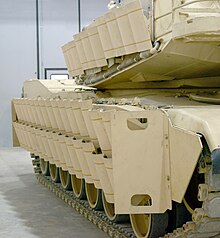
The Abrams may also be fitted with explosive reactive armor over the track skirts if needed (such as the Tank Urban Survival Kit)[131] and slat armor over the rear of the tank and rear fuel cells to protect against ATGMs.
The 105 mm M1 Abrams does not use spall liners, though three 105 mm rounds on the turret basket floor are covered with spall protection covers on the M1 tank variant.[132]
Damage control
The tank has a halon firefighting system to automatically extinguish fires in the crew compartment. The engine compartment has a firefighting system that is engaged by pulling a T-handle located on the left side of the hull. The Halon gas can be dangerous to the crew.[133] However, the toxicity of Halon 1301 gas at 7% concentration is much lower than the combustion products produced by fire in the crew compartment, and CO2 dump would be lethal to the crew.[134]
The crew compartment also contains small hand-held fire extinguishers. Fuel and ammunition are stored in armored compartments with blowout panels intended to protect the crew from the risk of the tank's own ammunition cooking off (exploding) if the tank is damaged. The main gun's ammunition is stored in the rear section of the turret, with blast doors that open under power by sliding sideways only to remove a round for firing, then automatically close. Doctrine mandates that the ammunition door must be closed before arming the main gun.[134]
NBC protection
Starting with the M1A1 variant nuclear, biological, chemical protection was provided by a turret overpressure system. Previously the Abrams crew had been required to don NBC suits in case of an NBC attack. NBC masks are still retained as a backup, and crews often train while wearing them to remain proficient and combat-effective in such a scenario.[135]
Tank Urban Survival Kit
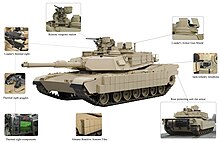

The Tank Urban Survival Kit (TUSK) is a series of improvements to the M1 Abrams intended to improve fighting ability in urban environments.[131] Historically, urban and other close battlefields have been poor places for tanks to fight. A tank's front armor is much stronger than that on the sides, top, or rear. In an urban environment, attacks can come from any direction, and attackers can get close enough to reliably hit weak points in the tank's armor or gain sufficient elevation to hit the top armor.
Armor upgrades include reactive armor on the sides of the tank and slat armor on the rear to protect against rocket-propelled grenades and other shaped charge warheads.[136] Abrams Reactive Armor Tile (ARAT) I consists of 32 XM19 reactive armor boxes added to the sides of the tank. ARAT II consists of rounded XM32 reactive armor tiles mounted over-top the XM19 tiles.[137] A Transparent Armor Gun Shield and a thermal sight system are added to the loader's top-mounted M240B 7.62 mm machine gun,[137] and a Kongsberg Gruppen Remote Weapon Turret carrying a 12.7 mm (.50 in) caliber machine gun (again similar to that used on the Stryker) is in place of the tank commander's original 12.7 mm (.50 in) caliber machine gun mount, wherein the commander had to expose himself to fire the weapon manually. An exterior telephone allows supporting infantry to communicate with the tank commander.[137]
In August 2006, General Dynamics Land Systems received a U.S. Army order for 505 Tank Urban Survivability Kits (TUSK) for Abrams main battle tanks supporting operations in Iraq, under a US$45 million contract. Deliveries were expected to be completed by April 2009.[138] Under a separate order, the U.S. Army awarded General Dynamics Armament and Technical Products (GDATP) US$30 million to produce reactive armor kits to equip M1A2s.[138]
Tiles will be produced at the company's reactive armor facility in Stone County Operations, McHenry, Mississippi. In December 2006, the U.S. Army added Counter Improvised Explosive Device enhancements to the M1A1 and M1A2 TUSK, awarding GDLS $11.3 million contract, part of the $59 million package mentioned above. In December, GDLS also received an order, amounting to around 40% of a US$48 million order, for loader's thermal weapon sights being part of the TUSK system improvements for the M1A1 and M1A2 Abrams Tanks.[138]
Active protection system

In addition to the armor, some USMC Abrams tanks were equipped with a Softkill Active protection system, the AN/VLQ-6 Missile Countermeasure Device (MCD) that can impede the function of guidance systems of some semi-active control line-of-sight (SACLOS) wire- and radio guided anti-tank missiles (such as the Russian 9K114 Shturm) and infrared homing missiles. These were not ready in time for the Gulf War. The MCD works by emitting a massive, condensed infrared signal to confuse the infrared homing seeker of an anti-tank guided missile (ATGM). However, the drawback to the system is that the ATGM is not destroyed, it is merely directed away from its intended target, leaving the missile to detonate elsewhere.[139] During the Iraq War the U.S. Marine Corps equipped its M1A1s with AN-VLQ-8A electro-optical jammers.[140]
In 2016, the U.S. Army and Marine Corps began testing the Israeli Trophy active protection system to protect their Abrams tanks from modern RPG and ATGM threats by either jamming (with ATGMs) or firing small rounds to deflect incoming projectiles.[141] The Army planned to field a brigade of over 80 tanks equipped with Trophy to Europe in 2020.[142] It is planned for up to 261 Abrams to be upgraded with the system, enough for four brigades.[143] In June 2018, the Army awarded Leonardo DRS, U.S. partner to Trophy's designer Rafael, a $193 million contract to deliver the system in support of M1 Abrams "immediate operational requirements".[144] U.S. Army M1A2 SEP v2 Abrams tanks deployed to Germany in July 2020 fitted with Trophy systems.[citation needed] Deliveries to equip four tank brigades were completed in January 2021.[145]
Armament
Primary
M68A1 rifled gun
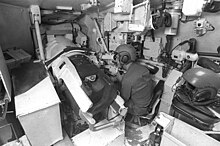
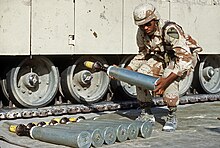
The main armament of the original model M1 and IPM1 was the M68A1 105 mm rifled tank gun firing a variety of APFSDS, HEAT, high explosive, white phosphorus rounds and an anti-personnel (multiple flechette) round. This gun used a license-made tube of the British Royal Ordnance L7 gun together with the vertical sliding breech block and other parts of the U.S. T254E2 prototype gun. However, a longer ranged weapon was always envisaged, with lethality beyond 1.9-mile (3 km) to combat newer armor technologies. To attain that lethality, the projectile diameter needed to be increased. The tank was able to carry 55 105 mm rounds, with 44 stored in the turret blowout compartment and the rest in hull stowage.
Being non-combustible, the empty cartridge cases of the M1 variant accumulated on the turret floor after firing. After allowing some time to cool, they were ejected out of the hatch by the loader.[115]
M256 smoothbore gun

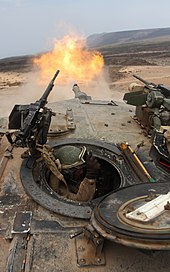
The main armament of the M1A1 and M1A2 is the M256 120 mm smoothbore gun, designed by Rheinmetall AG of Germany, manufactured under license in the U.S. by Watervliet Arsenal, New York. The M256 is an improved variant of the Rheinmetall 120 mm L/44 gun carried on the German Leopard 2 on all variants up to the Leopard 2A5, the difference being in thickness and chamber pressure. Leopard 2A6 replaced the L/44 barrel with a longer L/55. Due to the increased caliber, only 40 or 42 rounds are able to be stored depending on if the tank is an A1 or A2 model.
- Elevation: −9 to +20 degree
The M256 fires ammunition with combustible cartridge cases made out of nitrocellulose. The cartridges were safer against premature ignition and flarebacks than earlier combustible cartridge rounds, but not entirely accident-proof.[115]
The M256 fires a variety of rounds. The primary APFSDS round of the Abrams is the depleted uranium M829 round, of which four variants have been designed. M829A1, known as the "Silver Bullet", saw widespread service in the Gulf War, where it proved itself against Iraqi armor such as the T-72. The M829A2 APFSDS round was developed specifically as an immediate solution to address the improved protection of a Russian T-72, T-80U or T-90 main battle tank equipped with Kontakt-5 explosive reactive armor (ERA).[129]
Later, the M829A3 round was introduced in 2002 to improve its effectiveness against next-generation ERA equipped tanks.[146] Development of the M829 series is continuing with the M829A4 currently entering production, featuring advanced technology such as data-link capability.[147]
The Abrams also fires HEAT warhead shaped charge rounds such as the M830, the latest version of which (M830A1) incorporates a sophisticated multi-mode electronic sensing fuse and more fragmentation that allows it to be used effectively against armored vehicles, personnel, and low-flying aircraft. The Abrams uses a manual loader, who also provides additional support for maintenance, observation post/listening post (OP/LP) operations, and other tasks.
The new M1028 120 mm anti-personnel canister cartridge was brought into service early for use in the aftermath of the 2003 invasion of Iraq. It contains 1,098 3⁄8-inch (9.5 mm) tungsten balls that spread from the muzzle to produce a shotgun effect lethal out to 600 meters (2,000 ft). The tungsten balls can be used to clear enemy dismounts, break up hasty ambush sites in urban areas, clear defiles, stop infantry attacks and counter-attacks and support friendly infantry assaults by providing covering fire. The canister round is also a highly effective breaching round and can level cinder block walls and knock man-sized holes in reinforced concrete walls for infantry raids at distances up to 75 meters (246 ft).[148]
Also in use is the M908 obstacle-reduction round. It is designed to destroy obstacles and barriers. The round is a modified M830A1 with the front fuse replaced by a steel nose to penetrate into the obstacle before detonation.[149]
The U.S. Army Research Laboratory (ARL) conducted a thermal analysis of the M256 from 2002 to 2003 to evaluate the potential of using a hybrid barrel system that would allow for multiple weapon systems such as the XM1111 Mid-Range munition, airburst rounds, or XM1147. The test concluded that mesh density (number of elements per unit area) impacts accuracy of the M256 and specific densities would be needed for each weapon system.[150]
In 2013, the Army was developing a new round to replace the M830/M830A1, M1028, and M908. Called the M1147 Advanced Multi-Purpose XM1147 advanced multi-purpose (AMP) round, it will have point detonation, delay, and airburst modes through an ammunition data-link and a multi-mode, programmable fuse in a single munition. Having one round that does the job of four would simplify logistics and be able to be used on a variety of targets. The AMP is to be effective against bunkers, infantry, light armor, and obstacles out to 500 m (1,600 ft), and will be able to breach reinforced concrete walls and defeat ATGM teams from 500 to 2,000 m (1,600 to 6,600 ft).[151][152] Orbital ATK was awarded a contract to begin the first phase of development for the AMP XM1147 High-Explosive Multi-Purpose with Tracer cartridge in October 2015.[153] The AMP round has not entered full-rate production as of 2024.[154]
In addition to these, the XM1111 (Mid-Range-Munition Chemical Energy) was also in development. The XM1111 was a guided munition using a dual-mode seeker that combined imaging-infrared and semi-active laser guidance. The MRM-CE was selected over the competing MRM-KE, which used a rocket-assisted kinetic energy penetrator. The CE variant was chosen due to its better effects against secondary targets, providing a more versatile weapon. The Army hoped to achieve IOC with the XM1111 by 2013.[155] However, the Mid-Range Munition was canceled in 2010 along with Future Combat Systems.[156]
Secondary
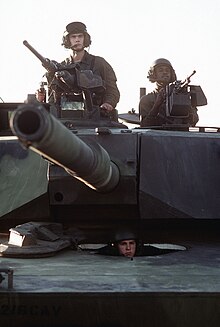
The Abrams tank has three machine guns, with an optional fourth:
- A .50 cal. (12.7 mm) M2HB machine gun in front of the commander's hatch. On the M1 and M1A1, this gun is mounted on the Commander's Weapons Station. This allows the weapon to be aimed and fired from within the tank. Normal combat loadout for the M1A1 is a single 100-round box of ammo at the weapon, and another 900 rounds carried. The later M1A2 variant had a "flex" mount that required the tank commander to expose his or her upper torso in order to fire the weapon. In urban environments in Iraq this was found to be unsafe. With the Common Remote Operated Weapons System (CROWS) add-on kit, an M2A1 .50 Caliber Machine gun, M240, or M249 SAW can be mounted on a CROWS remote weapons platform (similar to the Protector M151 remote weapon station used on the Stryker family of vehicles). Current variants of the Tank Urban Survival Kit (TUSK) on the M1A2 have forgone this,[citation needed] instead adding transparent gun shields to the commander's weapon station.[137] The upgrade variant called the M1A1 Abrams Integrated Management (AIM) equips the .50 caliber gun with a thermal sight for accurate night and other low-visibility shooting.[157]
- A 7.62 mm M240 machine gun in front of the loader's hatch on a skate mount (seen at right). Some of these were fitted with gun shields during the Iraq War, as well as night-vision scopes for low-visibility engagements and firing. This gun can be moved to the TC's position if the M2 .50 cal is damaged.
- A second 7.62 mm M240 machine gun in a coaxial mount (i.e., it points at the same targets as the main gun) to the right of the main gun. The coaxial MG is aimed and fired with the same computerized firing control system used for the main gun. On earlier M1 and M1A1s 3000 rounds are carried, all linked together and ready to fire. This was reduced slightly in later models to make room for new system electronics. A typical 7.62 mm combat loadout is between 10,000 and 14,000 rounds carried on each tank.
- (Optional) A second coaxial .50 cal. (12.7 mm) M2HB machine gun can be mounted directly above the main gun in a remote weapons platform as part of the CSAMM (Counter Sniper Anti Material Mount) package.
Aiming
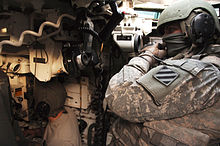
The Abrams is equipped with a ballistic fire-control computer that uses user and system-supplied data from a variety of sources to compute, display, and incorporate the three components of a ballistic solution—lead angle, ammunition type, tube wear, propellant temperature, wind speed, air temperature, the relative motions of the target and the Abrams, and range to the target—to accurately fire the main gun.[158] These three components are determined using a laser rangefinder, crosswind sensor, a pendulum static cant sensor, data concerning performance and flight characteristics of each specific type of round, tank-specific boresight alignment data, ammunition temperature, air temperature, barometric pressure, a muzzle reference system (MRS) that determines and compensates for barrel drop at the muzzle due to gravitational pull and barrel heating due to firing or sunlight, and target speed determined by tracking rate tachometers in the Gunner's or Commander's Controls Handles.
All of these factors are computed into a ballistic solution and updated 30 times per second. The updated solution is displayed in the Gunner's or Tank Commander's field of view in the form of a reticle in both day and thermal modes.[159] The ballistic computer manipulates the turret and a complex arrangement of mirrors so that all one has to do is keep the reticle on the target and fire to achieve a hit. Proper lead and gun tube elevation are applied to the turret by the computer, greatly simplifying the job of the gunner.[citation needed]
The fire control system on the M1 and M1A1 variants is the Computing Devices Canada ballistic computer system.[160] On the M1A2 the Fire Control Electronics Unit is manufactured by GDLS.[161] The laser designator is a Hughes model.[162]

The fire-control system uses this data to compute a firing solution for the gunner. The ballistic solution generated ensures a hit percentage greater than 95 percent at nominal ranges.[citation needed] Either the commander or gunner can fire the main gun. Additionally, the Commander's Independent Thermal Viewer (CITV) on the M1A2 can be used to locate targets and pass them on for the gunner to engage while the commander scans for new targets.
If the primary sight system malfunctions or is damaged, the main and coaxial weapons can be manually aimed using a telescopic scope boresighted to the main gun known as the Gunner's Auxiliary Sight (GAS). The GAS has two interchangeable reticles; one for HEAT and multi-purpose anti-tank (MPAT) ammunition and one for APFSDS and Smart Target-Activated Fire and Forget (STAFF) ammunition. Turret traverse and main gun elevation can be performed with manual handles and cranks if the fire control or hydraulic systems fail.
The commander's M2HB .50 caliber machine gun on the M1 and M1A1 is aimed by a 3× magnification sight incorporated into the Commander's Weapon Station (CWS), while the M1A2 uses the machine gun's own iron sights, or a remote aiming system such as the Common Remotely Operated Weapon Station (CROWS) system when used as part of the Tank Urban Survival Kit. The loader's M240 machine gun is aimed either with the built-in iron sights or with a thermal scope mounted on the machine gun.[citation needed]

In late 2017, the 400 USMC M1A1 Abrams were to be upgraded with better and longer-range sights on the Abrams Integrated Display and Targeting System (AIDATS) replacing the black-and-white camera view with a color sight and day/night thermal sight, simplified handling with a single set of controls, and a slew to cue button that repositions the turret with one command. Preliminary testing showed the upgrades reduced target engagement time from six seconds to three by allowing the commander and gunner to work more closely and collaborate better on target acquisition.[163][164]
Mobility
Tactical
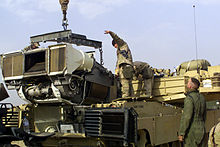
The M1 Abrams's powertrain consists of an AGT1500 multifuel gas turbine (originally made by Lycoming, now Honeywell) capable of 1,500 shaft horsepower (1,100 kW) at 30,000 rpm and 395 lb⋅ft (536 N⋅m) at 10,000 rpm and a six-speed (four forward, two reverse) Allison X-1100-3B Hydro-Kinetic automatic transmission. This gives it a governed top speed of 45 mph (72 km/h) on paved roads, and 30 mph (48 km/h) cross-country. With the engine governor removed, speeds of around 60 mph (97 km/h) are possible on an improved surface. However, damage to the drivetrain (especially to the tracks) and an increased risk of injuries to the crew can occur at speeds above 45 mph (72 km/h).
The tank was built around this engine[165] and it is multifuel-capable, including diesel, gasoline, marine diesel and jet fuel[166] (such as JP-4 or JP-8). In the AGT1500, jet fuel has poorer fuel economy and operating range compared to diesel. By 1989, the Army was transitioning solely to JP-8 for the M1 Abrams, part of a plan to reduce the service's logistics burden by using a single fuel for aviation and ground vehicles.[167] However, as of 2023, the U.S. Army frequently refuels the Abrams with diesel, which is also used by the Bradley Fighting Vehicle.[168] The Australian M1A1 AIM SA burns diesel fuel, since the use of JP-8 is less common in the Australian Army.[citation needed]
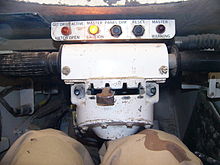
The gas turbine propulsion system has proven quite reliable in practice and combat, but its high fuel consumption is a serious logistic problem.[129] The engine burns more than 1.67 US gallons per mile (392 Liters/100 km) or (60 US gallons (230 L) per hour) when traveling cross-country and 10 US gallons (38 L) per hour when idle.[citation needed]
The turbine is very quiet when compared to diesel engines of similar power output and produces sound significantly different from a contemporary diesel tank engine, reducing the audible distance of the sound, thus earning the Abrams the nickname "whispering death" during its worldwide debut at the 1982 Reforger exercise.[169][170]
The Army received proposals, including two diesel options, to provide the common engine for the XM2001 Crusader and Abrams. In 2000, the Army selected the gas turbine engine LV100-5 from Honeywell and subcontractor General Electric.[171] The new LV100-5 engine was lighter and smaller (43% fewer parts) with rapid acceleration, quieter running, and no visible exhaust.[172] It also featured a 33% reduction in fuel consumption (50% less when idle) and near drop-in replacement.[173] The Common Engine Program was shelved when the Crusader program was canceled. Phase 2 of Army's PROSE (Partnership for Reduced O&S Costs, Engine) program, however, called for further development of the LV100-5 and replacement of the current AGT1500 engine.[174]


From 1991 to 1994, the Army fitted 1,500 Abrams turrets with external auxiliary power units (APU). APUs allow some the Abrams to run some functions without running on the engine. Some Abrams tanks that saw service during the Gulf War were fitted with such a device.[175] Although the Army favored an under-armor APU, Congress instead funded a short-term modification to 336 M1A2 Abrams. These were installed in 1997.[176] An under-armor APU located in the hull was chosen for the M1A2 SEP variant. When this proved unreliable, it was replaced with a battery-based Alternate APU starting in 2005.[175]
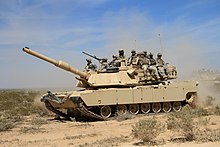
Although the M1 tank is not designed to carry riders easily, provisions exist for the Abrams to transport troops in tank desant with the turret stabilization device switched off. A battle-equipped infantry squad may ride on the rear of the tank, behind the turret. The soldiers can use ropes and equipment straps to provide handholds and snap links to secure themselves.[177]
The Abrams T156 is a permanently bonded rubber track pads, a distinctive feature not found on any other tank. Unlike other tanks with replaceable track pads, a worn track pad is remedied by replacing the entire track shoe. The Abrams nonremovable track pads save weight but are less desirable in snow as the pads cannot be replaced with grousers.[178] As of 2007, M1 Abrams track wear constitutes the second-largest consumable expense in the U.S. Army, surpassed only by Meals, Ready to Eat consumption.[179] In 1988 the Army awarded FMC Corporation a contract for T158 tracks rated for 2,100 miles (3,400 km), or about double the life of the previous shoe.[180] These feature replaceable pads and are about 3000 pounds heavier.[181]
The driver is equipped with a thermal viewer. On at least some models this is the Hughes AN/VAS-3.[182]
Strategic
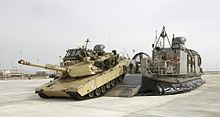

Strategic mobility is the ability of the tanks of an armed force to arrive in a timely, cost effective, and synchronized fashion. The Abrams can be carried by a C-5 Galaxy or a C-17 Globemaster III. The limited capacity (two combat-ready tanks in a C-5, one combat-ready tank in a C-17) caused serious logistical problems when deploying the tanks for the first Gulf War, though there was enough time for 1,848 tanks to be transported by ship.
The Marines transported their Marine Air-Ground Task Force Abrams tanks by combat ship. A Wasp-class Landing Helicopter Dock (LHD) typically carried a platoon of four to five tanks attached to the deployed Marine Expeditionary Unit, which were then amphibiously transported to shore by Landing Craft Air Cushion (LCAC) at one combat-ready tank per landing craft.
The Abrams is also transportable by truck, namely the Oshkosh M1070 and M1000 Heavy Equipment Transporter System (HETS) for the US Military. The HETS can operate on highways, secondary roads, and cross-country. It accommodates the four tank crew members.[183] The Australian Army uses customized MAN trucks to transport its Abrams.[184]
The first instance of the Abrams being airlifted directly into a battlefield occurred in October 1993. Following the Battle of Mogadishu, 18 M1 tanks were airlifted by C-5 aircraft to Somalia from Hunter Army Airfield, Georgia.[185][186]
Crew responsibilities and platoon operations
When the Abrams entered U.S. Army service in 1980, its arrival marked an organizational change. The standard tank platoon fell from five tanks — a number consistent since the first days of the Tank Corps in World War I — to four. The change reflected both the improved capability of the new tank but also its cost. The reduction in platoon size necessitated changes in tactics oriented upon platoon and section actions in which the platoon leader had both to fight his tank and manage the unit.[187]

Platoon organization within the U.S. Army and U.S. Marine Corps as of 2019 is as follows:
A tank platoon includes four Abrams MBTs organized into two sections, with two tanks in each section. "A" section consists of the platoon leader (platoon commander in USMC parlance) who is the commander of the vehicle designated as Tank 1, and the platoon leader’s wingman, who is the commander of Tank 2. "B" section consists of the platoon sergeant, who is the tank commander of Tank 4, and Tank 3 is the platoon sergeant’s wingman.[188]
The wingman concept requires that individual tanks orient off the tank to its left or right side. In the tank platoon, Tank 2 orients off the platoon leader’s tank, while Tank 3 orients off the platoon sergeant’s tank. The platoon sergeant orients off the platoon leader’s tank.
The tank platoon is organic to Armor companies of a combined arms battalion. The platoon may be attached to a number of organizations, commonly a mechanized infantry company, to create company teams. It may also be placed under the control of an Infantry organization. The exact amount of control the gaining unit would have is determined by the command relationship established by its higher HQ.[189]
The Armor company is organized, equipped, and trained to fight pure or as a task organized company team. The Armor company includes an HQ and three tank platoons. The company HQ is equipped with two MBTs, armored personnel carriers, and wheeled vehicles for mission command/command and control and sustainment.[190]
Variants and upgrades
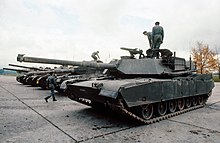
- General Motors XM1 validation phase prototype.[191]
- Chrysler XM1 validation phase prototype.[192]
- XM1-FSED: Chrysler preproduction test model. Eleven Full-Scale Engineering Development test bed vehicles were produced in 1977–78. These vehicles were also called Pilot Vehicles and numbered PV-1 through PV-11.
- M1: First production variant. Production began in 1979 and continued to 1985 (3,273 built for the United States). The first 110 tanks were low rate initial production (LRIP) models, still called XM1s, because they were built before the tank was type-classified as the M1.[citation needed] The M1 variant was retired from active U.S. Army service in 1996.[193]
- IPM1 (Improved Performance): Produced from 1984 to 1986 concurrent to the M1A1. It contained upgrades and reconfigurations like a rear storage bustle rack, improved armor suspension, transmission, and final drives. (894 built for United States).[194]
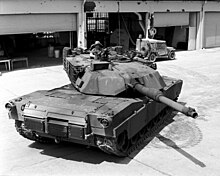
- M1A1:[nb 3] Production started in 1985 and continued to 1992, pressurized NBC system, rear bustle rack for improved stowage of supplies and crew belongings, redesigned blowoff panels and M256 120 mm smoothbore cannon (4,976 built for the U.S. Army, 221 for USMC, 59 M1A1 AIM SA sold to Australia).
- M1A1HA (Heavy Armor): Added first generation depleted uranium armor components. Some tanks were later upgraded with second generation depleted uranium armor components, and are unofficially designated M1A1HA+.
- M1A1HC (Heavy Common): Added new second generation depleted uranium armor components, digital engine control and other small upgrades common between Army and Marine Corps tanks.
- M1A1D (Digital): A digital upgrade for the M1A1HC, to keep up with M1A2 SEP, manufactured in quantity for only 2 battalions.
- M1A1 AIM v.1 (Abrams Integrated Management): A program whereby older units are reconditioned to zero hour conditions;[195] and the tank is improved by adding Forward-Looking InfraRed (FLIR) and Far Target Locate sensors, a tank-infantry phone, communications gear, including FBCB2 and Blue Force Tracking to aid in crew situational awareness, and a thermal sight for the .50 caliber machine gun.[157]
- M1A1 AIM v.2/M1A1SA (Situational Awareness): Upgrades similar to AIM v.1 tanks + new third generation depleted uranium armor components. Configuration for the Royal Moroccan Army, which is almost identical to the Australian variant, except exportable turret armor is installed by General Dynamics Land System to replace the DU armor.[196]
- M1A1 FEP (Firepower Enhancement Package): Similar upgrade to AIM v.2 for USMC tanks.
- M1A1KVT (Krasnovian Variant Tank): M1A1s that have been visually modified to resemble Soviet-made tanks for use at the National Training Center, fitted with MILES gear and a Hoffman device.
- M1A1M: An export variant ordered by the Iraqi Army.[197]
- M1A1 (AIDATS upgrade): Upgrade-only variant to all USMC General Dynamics M1A1 Abrams tanks to improve the tank commander's situational awareness with an upgraded thermal sight, color day camera, and a stationary color display.[198]
- M1A2 (Baseline): Production began in 1992 and initial operating capability achieved in 1993.[199] (77 built for the U.S. and more than 600 M1s upgraded to M1A2, 315 for Saudi Arabia, 1,005 for Egypt, 218 for Kuwait). The M1A2 offers the tank commander an independent thermal sight and ability to, in rapid sequence, shoot at two targets without the need to acquire each one sequentially, also second-generation depleted uranium armor components.[195]
- M1A2 SEP (System Enhancement Package): Is fitted with new, second-generation gunner's thermal sight.[200] Has upgraded third-generation depleted uranium armor components with graphite coating (240 new built, 300 M1A2s upgraded to M1A2 SEP for the United States, also unknown numbers of upgraded basic M1s and IPM1s, also 400 oldest M1A1s upgraded to M1A2 SEP).
- M1A2S (Saudi Package): Saudi Arabian variant upgrade of the M1A2 based on M1A2 SEP, with some features, such as depleted uranium armor, believed to be missing and replaced by special armor. (442 M1A2s upgraded to M1A2S).[201][202]
- M1A2 SEPv2: Added Common Remotely Operated Weapon Station low-profile as standard, color displays, improved interfaces, a new operating system, improved crew-compartment cooling, and new second generation thermal optics.[203]
- M1A2 SEPv3 (formerly M1A2C): Has increased power generation and distribution, better communications and networking, new Vehicle Health Management System (VHMS) and Line Replaceable Modules (LRMs) for improved maintenance, an Ammunition DataLink (ADL) to use airburst rounds, improved counter-IED armor package, Next Generation Armor Package (NGAP),[204] and an Auxiliary Power Unit (APU) under armor to run electronics while stationary instead of the engine, visually distinguishing the version by a small exhaust at the left rear. More passive ballistic protection added to the turret faces, along with new Explosive Reactive Armor mountings (Abrams Reactive Armor Tile (ARAT))[205] and Trophy Active Protection systems added to the turret sides. Prototypes began testing in 2015,[206]
- M1A2T: Special configuration variant of the M1A2 SEPv3 reportedly being offered for sale to Taiwan as of March 2019 and approved by United States Department of State as of July 2019.[207] Per DSCA statement, it is roughly equivalent to M1A2 SEPv3, except depleted uranium armor is replaced by FMS export armor. There is no mention of the Trophy APS system. The new-built tanks will be produced at Anniston Army Depot, Anniston, Alabama, and the Joint Systems Manufacturing Center, Lima, Ohio.[208][209]
- M1A2R: Variant for the Romanian Army, currently under development.[210] According to the chief of the General Directorate for Armaments, the Romanian Abrams variant will be a configuration of the M1A2 SEPv3.[211]
- M1A2 SEPv4 (formerly M1A2D, canceled): The 2-12 Cavalry Regiment received the first M1A2 SEPv4 tank as of 21 January 2023[update].[212] It was previously under development as of 29 March 2022[update].[213] The Commander's Primary Sight, also known as the Commander's Independent Thermal Viewer, and Gunner's Primary Sight will be upgraded with third Gen FLIR, an improved laser rangefinder and color cameras. Additional improvements will include advanced meteorological sensors, laser warning/detection receivers, directional smoke grenade launchers and integration of the new XM1147 (AMP) 120 mm tank round.[214][215][216] The AN/VVR-4 laser warning receiver and ROSY rapid obscurant system have been trialed by the US Army for adoption on the Abrams tank and Bradley fighting vehicle.[217][218][219] The M1A2 SEPv4 variant was officially canceled by the U.S. Army on 6 September 2023. The Army plans to develop a new variant of the Abrams, designated M1E3, to enter service in the 2030s.[109]
- M1A2-K: Under development, unique variant for the Kuwaiti Army, slated to replace Kuwait's current M1A2 fleet.[220]
- M1E3: Under development as of 2023. On 6 September 2023, the U.S. army announced that it had canceled the planned M1A2 SEPv4 variant and would instead redirect resources into a new variant of the Abrams tank, named M1E3. The new variant will include modular open-systems architecture and is designed to be lighter and more survivable on the battlefield.[109]
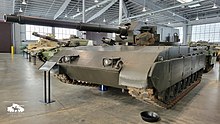
- M1 Abrams Block III Tank Test Bed (M1 TTB) was a prototype built in 1983 as part of TACOM's Abrams Block III program (whose purview was to eventually create the M1A3), featuring an unmanned turret with a 44-caliber 120 mm M256 smoothbore gun, three crew members sitting side by side inside an armored capsule at the front of the hull and a suite of cameras and thermal viewers to preserve the crew's situational awareness. The main armament was linked to a Meggitt mechanical autoloader and a 44-round vertical ammunition carousel inside the turret basket;[221] this system could provide a sustained rate of fire of 10 rounds per minute and successfully completed over 40,000 round loading/unloading cycles without malfunctioning during testing. Due to the absence of a full-fledged manned turret and the lack of internal armor packages, the vehicle only weighed 45 tons.[222] The program was cancelled after the end of the Cold War and its only prototype is now on display at the U.S. Army Armor & Cavalry Collection at Fort Moore, Georgia.
- M1 Thumper (also known as ATAC Demonstration System) was a single M1A1[223] fitted with a heavily modified turret to trial the experimental XM291 ATAC (sometimes referred to as LW120) smoothbore gun, a more powerful replacement for the M256 capable of firing either single-piece 120 mm or two-piece 140 mm ammunition with only a barrel change. The 140 mm rounds were too large (boasting twice the chamber volume of a M829 APFSDS and twice the muzzle energy) and heavy to be moved around by a human loader, mandating the installation of a XM91 mechanical cassette autoloader. The Thumper underwent testing in 1988 and in the 1990s at Aberdeen Proving Ground,[224][225] where it demonstrated accuracy equal to an M1A1's but with significantly higher armor penetration capability.

- Component Advanced Technology Test Bed (CATTB) was a pair of highly modified prototypes conceived under the auspices of the Advanced Tank Armament Systems (ATAS) program[224] to test several promising technologies. Two vehicles were built in 1993 and 1994: the first one, dubbed Phase I, paired a spare M1 hull with a modified turret (an evolution of the M1 Thumper's) fitted with a 48-caliber 140 mm Watervliet Arsenal XM291 smoothbore cannon[226] and a Benét Labs XM91 mechanical autoloader inside the bustle; the second vehicle, codenamed Phase II, used the same turret as basis, but mated it to a brand new M1 hull altered to contain a more compact Cummins XAP-1000 AIPS diesel engine and two vertically-stacked, horizontal carousels (for non-ready ammunition) between the turret basket and the powerpack compartment. Phase II also trialed new single-shoe XT166 tracks (Phase I retained the original, two-shoed T156 of the M1), an in-arm hydropneumatic suspension and the Multi-Sensor Target Acquisition System (MTAS) with its low-power, millimetric wave radar. Both vehicles were tested extensively at Aberdeen Proving Ground. The aforementioned Thumper is often erroneously described as a de-tuned CATTB, although it predates the latter by five years.[227][228]

- AbramsX is a technology demonstrator[229] of the M1 Abrams series by General Dynamics Land Systems. The AbramsX features a lightweight Watervliet Arsenal XM360 smoothbore gun with pepperpot muzzle brake, an autoloader which reduces the crew to three, an unmanned turret, a hybrid diesel-electric Cummins ACE power pack that gives 50% more fuel efficiency, a 30 mm XM914 chain gun in a remote weapon station, Trophy active protection systems with three launchers, an augmented reality suite that would increase the crews' situational awareness thanks to cameras and sensors mounted around the tank's exterior, a silent mode when running on electric power, the ability to be updated more easily than existing tanks and use loitering munitions such as the AeroVironment Switchblade as well as surveillance drones,[citation needed] and reduced weight for improved mobility. In October 2022, GDLS released a video showing the Technology Demonstrator and various technology tests.[230][231]
Specialized
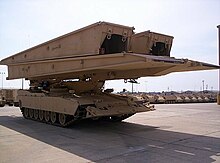
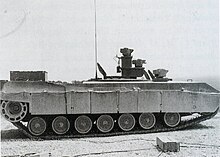
- Surrogate Research Vehicle: The surrogate research vehicle (SRV) project was conducted from 1980 to 1987 to evaluate the effectiveness of different crew arrangements using a turretless Abrams test bed. These modifications included adding two crew stations to the front hull. Two crew positions were retained in a rotating basket where the turret had been.[232]
- Armored Recovery Vehicle: Initially known as the RV90, this was a prototype designed by General Dynamics. It was produced under contract with TACOM in 1988 despite an earlier preliminary decision to procure the M88A1E1.[233] The prototype was evaluated against the M88A1E1 later that year.[234] The Abrams RV was based on the Abrams chassis, but housed a crew of three in a unique armored superstructure. The Army selected the M88A1E1 regardless,[233] which went into production as the M88A2 Hercules.[234]
- Air Ground Defense System (AGDS): Proposed air defense variant of the Abrams equipped with dual 35 mm Bushmaster III autocannons, 12 ADATS missiles and advanced electro-optical and radar targeting systems derived from the ADATS. It was supposed to be capable of both air defense and anti-tank purposes with the ADATS MIM-146 missiles which was a dual purpose ATGM/SAM. The proposal never saw consideration and was never developed further.[235]
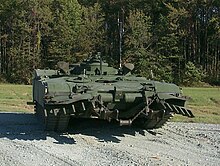
- M1 Panther II: A mine-clearing vehicle with turret removed, mine rollers on the front, and magnetized dog bone.[236][237] This could be operated remotely or with a crew of two. Six were built and two were deployed in 2007 by the USMC in Iraq.[238]
- M104 Wolverine Heavy Assault Bridge: GDLS produced these under contract for the U.S. Army with testing beginning in 1996. The 26 meters (85 ft) bridge was produced by Krauss-Maffei Wegmann. The chassis is an Abrams converted to M1A2 standard. Forty-three units were produced when production wrapped up in 2003.[102]
- Battle Command Vehicle: The vehicle was visually modified with a mock M256 gun to appear like an ordinary Abrams MBT, but featured communications equipment and workstations for battle commanders. United Defense LP constructed a prototype which the Army tested at Fort Hood in 1997.[239]
- Visually modified: The National Training Center possesses 28 visually modified M1A1s resembling T-80s.[102]

- M1 Grizzly (Breacher): In 1997 TACOM awarded United Defense a $129 million contract to construct this vehicle based on the Abrams chassis. This was capable of clearing minefields and demolishing obstacles with its dozer blade and telescopic power-driven arm. The chassis had suspension of M1A2 standard and was operated by a crew of two. Two vehicles were delivered to the Army in 1999. Development was halted by the following year.[240]

- M1074 Joint Assault Bridge (JAB): Bridgelayer combining a heavy "scissor" bridge with the M1 Abrams chassis. Expected to reach low-rate initial production in 2019 to replace the M60 AVLB and M104 Wolverine.[241]
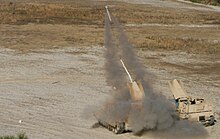
- M1150 Assault Breacher Vehicle (ABV): Assault variant for the USMC. Based upon the M1A1 Abrams chassis, the Assault Breacher Vehicle has a variety of systems installed, such as a full-width mine plow, two linear demolition charges, and a lane-marking system. Reactive armor has been fitted to the vehicle providing additional protection against HEAT warhead-based weapons. The turret has been replaced by a new smaller one with two MICLIC launchers at its rear. A M2HB .50 machine gun in a remote weapons station is mounted on the commander's cupola and a bank of grenade launchers are fitted to each side of the superstructure to cover the frontal arc for self-protection.[242]
Additional equipment
- Mine clearing plows: An early example consisted of two mine plows and a chain with a weight running between them.[243] The Mine Clearing Blade System (MCBS): It is capable of clearing mines up to 6 feet in front of the tank's path.[244]
- Mine-clearing rollers: The Tank Mounted Mine Clearing Roller (TMMCR) comprises two roller banks of five discs each and a chain with a weight running between the rollers.[243] Self Protection Combat Roller (SPCR) targets pressure activated explosive devices. The system comprises two 4-wheel roller gangs.[245] An optional Magnetic System Duplicator (MSD) can be fitted to help protect the equipment from the effect of magnetic influence fused mines.[246]
- Surface Clearance Device (SCD): The SCD is employed to clear surface laid mines and IEDs from roads, trails and rough terrain. There are two versions of the SCD; a V-blade optimised for clearing routes and a straight angle-blade which is optimised for clearing staging and assembly areas.[247]
- Vehicle Magnetic Signature Duplicator (VEMSID): The VEMSID causes detonation of magnetic influence mines. The system comprises four emitter coils, two associated power boxes and an MSD Control Unit (MSDCU).[248]
- Bulldozer attachment. The U.S. Army tested this attachment in 1982.[102] This was unsuccessful in part because it resulted in transmission overheating,[243] and was never used.[102]
Specifications
| M1[249] | IPM1[250] | M1A1[6] | M1A2[251] | M1A2 SEP | |
|---|---|---|---|---|---|
| Produced | 1979–85 | 1984–1986[252] | 1985–92 | 1992 on | 1999 on |
| Length (gun forward) | 32 ft 0.5 in (9.77 m) | 32 ft 2.9 in (9.83 m) | |||
| Width (over skirt) | 12 ft (3.7 m) | ||||
| Height (over 0.50 machine gun) | 9 ft 5.6 in (2.885 m) | n/a | |||
| Top speed (level road) | 45 mph (72 km/h) | 41.5 mph (66.8 km/h) | 42 mph (68 km/h) | ||
| Range | 275 mi (443 km) | 289 mi (465 km) | 265 mi (426 km) | 264 mi (425 km) | |
| Power | 1,500 shp (1.1 MW) at 3000 rpm | ||||
| Combat Weight | 58 short tons (53 t) | 60 short tons (54 t) | M1A1: 63 short tons (57 t)[253] M1A1SA: 67.6 short tons (61.3 t) |
69.5 short tons (63.0 t) | SEP v1: 69.5 short tons (63.0 t) SEP v2: 71.2 short tons (64.6 t)SEP v3: 73.6 short tons (66.8 t) |
| Main armament | 105 mm M68A1 rifled | 120 mm M256 smoothbore | |||
| Crew | 4 (commander, gunner, loader, driver) | ||||
Operators
Current operators




 Australia – Australian Army: 59 M1A1 (AIM) configuration tanks (hybrids with a mix of equipment used by U.S. Army and U.S. Marine Corps but without depleted uranium layers in armor). They were bought from the U.S. in 2006 and replaced the Leopard AS1 in 2007.[254] As of 2017, the Australian Government was considering expanding the Army's fleet of Abrams to 90 tanks.[255] In April 2021, the U.S. granted an FMS for 160 M1A1 tank hulls to produce 75 M1A2 SEPv3 tanks, 29 M1150 Assault Breacher Vehicles and 18 M1074 Joint Assault Bridges, including the development of a unique armor package for the Australian Army.[256] In January 2022, Australia committed to purchase 120 tanks and armored vehicles, including 75 M1A2s, at a total cost of $3.5 billion and to be delivered in 2024; the M1A2s will replace their 59 M1A1s.[257][258]
Australia – Australian Army: 59 M1A1 (AIM) configuration tanks (hybrids with a mix of equipment used by U.S. Army and U.S. Marine Corps but without depleted uranium layers in armor). They were bought from the U.S. in 2006 and replaced the Leopard AS1 in 2007.[254] As of 2017, the Australian Government was considering expanding the Army's fleet of Abrams to 90 tanks.[255] In April 2021, the U.S. granted an FMS for 160 M1A1 tank hulls to produce 75 M1A2 SEPv3 tanks, 29 M1150 Assault Breacher Vehicles and 18 M1074 Joint Assault Bridges, including the development of a unique armor package for the Australian Army.[256] In January 2022, Australia committed to purchase 120 tanks and armored vehicles, including 75 M1A2s, at a total cost of $3.5 billion and to be delivered in 2024; the M1A2s will replace their 59 M1A1s.[257][258] Egypt – Egyptian Army: 1,360 M1A1 tanks assembled in Egypt for the Egyptian Army in cooperation with the U.S.[259][260]
Egypt – Egyptian Army: 1,360 M1A1 tanks assembled in Egypt for the Egyptian Army in cooperation with the U.S.[259][260] Iraq – Iraqi Army: Iraq purchased 120 M1A1SA from the U.S. in 2008.[102] The first 11 tanks were delivered to the Iraqi Army in August 2010[261] with all deliveries completed by August 2011.[262] In October 2012, it was reported that six more tanks were being delivered.[263] Four battalions of the 9th Armoured Division were equipped with M1s by 2014: 1st and 2nd of the 34th Brigade, and 4th and 5th of the 35th Brigade. Iraq purchased 175 more M1A1 in 2014, though it is unclear if these were delivered.[264]
Iraq – Iraqi Army: Iraq purchased 120 M1A1SA from the U.S. in 2008.[102] The first 11 tanks were delivered to the Iraqi Army in August 2010[261] with all deliveries completed by August 2011.[262] In October 2012, it was reported that six more tanks were being delivered.[263] Four battalions of the 9th Armoured Division were equipped with M1s by 2014: 1st and 2nd of the 34th Brigade, and 4th and 5th of the 35th Brigade. Iraq purchased 175 more M1A1 in 2014, though it is unclear if these were delivered.[264] Kuwait – Kuwaiti Army: 218 M1A2s[265]
Kuwait – Kuwaiti Army: 218 M1A2s[265] Poland – Polish Land Forces: 69 M1A1 FEP in service. Poland has bought 250 M1A2 SEP v3 tanks. Production is set to finish by 2024, and delivery in early 2025. After the donation of over 200 Polish T-72 tanks to Ukraine, an agreement between the Polish and American governments was signed to buy 116 ex-U.S. M1A1s.[266] Delivery is expected to start in 2022. 7 loaned training tanks have already been delivered to Poland as of July 2022. The total purchase cost with support vehicles, crew training, and large supply of ammunition will cost PLN 23.3 billion (approximately $6 billion). They are to supplement 247 Leopard 2PL main battle tanks as well as older T-72 and PT-91 tanks.[267][268][269] 28 M1A2 SEPv2 tanks were leased in July 2022 to train crews until deliveries begin.[270] The first 14 of the 116 M1A1s ordered arrived on 28 June 2023.[271] A further 26 were delievered in November 2023.[272] 29 more delievered on 8 January 2024.[273]
Poland – Polish Land Forces: 69 M1A1 FEP in service. Poland has bought 250 M1A2 SEP v3 tanks. Production is set to finish by 2024, and delivery in early 2025. After the donation of over 200 Polish T-72 tanks to Ukraine, an agreement between the Polish and American governments was signed to buy 116 ex-U.S. M1A1s.[266] Delivery is expected to start in 2022. 7 loaned training tanks have already been delivered to Poland as of July 2022. The total purchase cost with support vehicles, crew training, and large supply of ammunition will cost PLN 23.3 billion (approximately $6 billion). They are to supplement 247 Leopard 2PL main battle tanks as well as older T-72 and PT-91 tanks.[267][268][269] 28 M1A2 SEPv2 tanks were leased in July 2022 to train crews until deliveries begin.[270] The first 14 of the 116 M1A1s ordered arrived on 28 June 2023.[271] A further 26 were delievered in November 2023.[272] 29 more delievered on 8 January 2024.[273] Saudi Arabia – Saudi Arabian Army: 373 Abrams tanks,[274] To be upgraded to M1A2S configuration in Saudi Arabia.[274] 69 more M1A2S tanks ordered on 8 January 2013, to be delivered by 31 July 2014.[275]
Saudi Arabia – Saudi Arabian Army: 373 Abrams tanks,[274] To be upgraded to M1A2S configuration in Saudi Arabia.[274] 69 more M1A2S tanks ordered on 8 January 2013, to be delivered by 31 July 2014.[275] Morocco – Royal Moroccan Army: 222 M1A1 SA (situational awareness) tanks ordered in 2015.[276][277] Deliveries under the contract started in July 2016[278] with an estimated completion date of February 2018. The contract include 150 refurbished and upgraded tanks to the special armor configuration.[279] Morocco took delivery of the first batch of M1A1SAs on 28 July 2016.[280] A Foreign Military Sale for 162 M1A2Ms was approved by the U.S. Department of State in November 2018 and sent to Congress for final approval.[281] In October 2020 General Dynamics Land Systems was awarded a $11.9 million contract to upgrade 162 Abrams tanks to the M1A2 SEPv3 configuraton. The contract was completed in March 2022.[282]
Morocco – Royal Moroccan Army: 222 M1A1 SA (situational awareness) tanks ordered in 2015.[276][277] Deliveries under the contract started in July 2016[278] with an estimated completion date of February 2018. The contract include 150 refurbished and upgraded tanks to the special armor configuration.[279] Morocco took delivery of the first batch of M1A1SAs on 28 July 2016.[280] A Foreign Military Sale for 162 M1A2Ms was approved by the U.S. Department of State in November 2018 and sent to Congress for final approval.[281] In October 2020 General Dynamics Land Systems was awarded a $11.9 million contract to upgrade 162 Abrams tanks to the M1A2 SEPv3 configuraton. The contract was completed in March 2022.[282] Taiwan – Republic of China Army: Taiwan considered purchasing upwards of 200 M1s, which was later reduced with the intention of acquiring 120 M1A1 tanks.[283] The Ministry of National Defence stated in 2016 that it was discussing sales of M1A1s with the U.S.[284] This plan was apparently canceled by October 2017; instead the Taiwanese government sought to upgrade its existing M60A3s with a 120 mm main gun and new ballistics computer.[285] In July 2018, Taiwan's Ministry of National Defense budgeted money to buy 108 M1A2s from the U.S. to replace its aging CM-11 Brave Tiger and M60A3 TTS tanks.[286] The U.S. Department of State approved the $2.2 billion sale in July 2019.[287][288] A sale of 108 M1A2Ts was later finalized.[289] The first two were delivered to Taiwan in June 2022.[290][291]
Taiwan – Republic of China Army: Taiwan considered purchasing upwards of 200 M1s, which was later reduced with the intention of acquiring 120 M1A1 tanks.[283] The Ministry of National Defence stated in 2016 that it was discussing sales of M1A1s with the U.S.[284] This plan was apparently canceled by October 2017; instead the Taiwanese government sought to upgrade its existing M60A3s with a 120 mm main gun and new ballistics computer.[285] In July 2018, Taiwan's Ministry of National Defense budgeted money to buy 108 M1A2s from the U.S. to replace its aging CM-11 Brave Tiger and M60A3 TTS tanks.[286] The U.S. Department of State approved the $2.2 billion sale in July 2019.[287][288] A sale of 108 M1A2Ts was later finalized.[289] The first two were delivered to Taiwan in June 2022.[290][291]
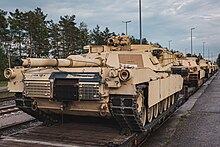
 Ukraine – Ukrainian Ground Forces: 31 M1A1 SA (Situational awareness).[292] 31 M1 Abrams were delivered at an unknown date, as part of U.S. support for Ukraine.[citation needed] As of 21 March 2023, the United States government is offering to supply Ukraine with older M1A1 Abrams tanks, "that have been upgraded very similar capability to the M1A2", as opposed to newer M1A2 tanks in an effort to speed up delivery. According to Pentagon Press Secretary U.S. Air Force Brigadier General Pat Ryder these tanks are to be delivered "by Fall" 2023 instead of the original delivery time of mid-2024. These tanks are to be taken from existing M1A1 "excessive hulls" from United States stocks and modernized to the required standard.[293][294][295] In April, the U.S. announced that the Abrams tanks will soon be sent to Germany so that Ukrainian soldiers could start training on them.[296] On 6 September, the U.S. said it would supply Ukraine with depleted uranium ammunition for Abrams tanks, despite initially refusing to do so.[297] On 8 September, it was reported that, at Ukraine's request, the Pentagon had extended the training period for Ukrainian soldiers on Abrams tanks by a few more weeks until the promised batch of tanks is refitted and prepared for delivery.[298] On 25 September, it was reported that Ukraine had received its first shipment of M1 tanks.[299][300]
Ukraine – Ukrainian Ground Forces: 31 M1A1 SA (Situational awareness).[292] 31 M1 Abrams were delivered at an unknown date, as part of U.S. support for Ukraine.[citation needed] As of 21 March 2023, the United States government is offering to supply Ukraine with older M1A1 Abrams tanks, "that have been upgraded very similar capability to the M1A2", as opposed to newer M1A2 tanks in an effort to speed up delivery. According to Pentagon Press Secretary U.S. Air Force Brigadier General Pat Ryder these tanks are to be delivered "by Fall" 2023 instead of the original delivery time of mid-2024. These tanks are to be taken from existing M1A1 "excessive hulls" from United States stocks and modernized to the required standard.[293][294][295] In April, the U.S. announced that the Abrams tanks will soon be sent to Germany so that Ukrainian soldiers could start training on them.[296] On 6 September, the U.S. said it would supply Ukraine with depleted uranium ammunition for Abrams tanks, despite initially refusing to do so.[297] On 8 September, it was reported that, at Ukraine's request, the Pentagon had extended the training period for Ukrainian soldiers on Abrams tanks by a few more weeks until the promised batch of tanks is refitted and prepared for delivery.[298] On 25 September, it was reported that Ukraine had received its first shipment of M1 tanks.[299][300] United States – United States Army received over 8,100 M1, M1A1 and M1A2 tanks combined.[129]
United States – United States Army received over 8,100 M1, M1A1 and M1A2 tanks combined.[129]
- U.S. Army – 2,645 total, 650 M1A1SA, 1,605 M1A2 SEPv2, 390 M1A2 SEPv3 (some 3,450 more M1A1 and M1A2 in storage).[301]
Future operators
 Romania – Romanian Land Forces: On 7 March 2023, a senior defense official announced that the Romanian Land Forces is in the process of advancing a proposal for the purchase of an Abrams tank battalion. In May 2023, the decision to buy 54 used M1A2 Abrams from United States Army stocks was approved by the Parliament of Romania.[302][303] The Romanian M1A2 variant is designated M1A2R.[304][210] On 9 November 2023, the U.S. Defense Security Cooperation Agency announced that the Department of State had approved the possible Foreign Military Sale to Romania for 54 M1A2 tanks and related equipment for an estimated cost of $2.53 billion.[305]
Romania – Romanian Land Forces: On 7 March 2023, a senior defense official announced that the Romanian Land Forces is in the process of advancing a proposal for the purchase of an Abrams tank battalion. In May 2023, the decision to buy 54 used M1A2 Abrams from United States Army stocks was approved by the Parliament of Romania.[302][303] The Romanian M1A2 variant is designated M1A2R.[304][210] On 9 November 2023, the U.S. Defense Security Cooperation Agency announced that the Department of State had approved the possible Foreign Military Sale to Romania for 54 M1A2 tanks and related equipment for an estimated cost of $2.53 billion.[305]
 Bahrain – Royal Bahraini Army: On 19 March 2024, the U.S. Defense Security Cooperation Agency announced that the Department of State had approved the possible Foreign Military Sale to Bahrain of 50 M1A2 SEPv3 Abrams Main Battle Tanks. Along with the tanks, Bahrain will receive 4 M88A2 HERCULES Combat Recovery Vehicles, 8 M1110 Joint Assault Bridges, 8 M1150 Assault Breacher Vehicles and 8 Heavy Assault Scissor Bridges (HASB). The estimated cost is $2.2 billion.[306]
Bahrain – Royal Bahraini Army: On 19 March 2024, the U.S. Defense Security Cooperation Agency announced that the Department of State had approved the possible Foreign Military Sale to Bahrain of 50 M1A2 SEPv3 Abrams Main Battle Tanks. Along with the tanks, Bahrain will receive 4 M88A2 HERCULES Combat Recovery Vehicles, 8 M1110 Joint Assault Bridges, 8 M1150 Assault Breacher Vehicles and 8 Heavy Assault Scissor Bridges (HASB). The estimated cost is $2.2 billion.[306]
Former operators
 United States – United States Marine Corps: In 2020 the Marine Corps announced the disbandment of its tank units, citing a pivot towards amphibious warfare by implementing Force Design 2030.[307] All 450 of the Marine Corps M1 Abrams MBTs were transferred to the U.S. Army with withdrawal from Marine Corps service being completed in May 2021.[308]
United States – United States Marine Corps: In 2020 the Marine Corps announced the disbandment of its tank units, citing a pivot towards amphibious warfare by implementing Force Design 2030.[307] All 450 of the Marine Corps M1 Abrams MBTs were transferred to the U.S. Army with withdrawal from Marine Corps service being completed in May 2021.[308]
See also
- List of the United States military vehicles by model number
- List of main battle tanks by country
- List of main battle tanks by generation
- Unmanned ground vehicle
References
Footnotes
Notes
Citations
- ^ Rader, Craig (30 May 2017). "Factory tour shows how an Abrams comes to life". Defense Logistics Agency. Archived from the original on 21 January 2023. Retrieved 27 May 2023.
- ^ "Egypt continues to produce locally M1A1 Abrams main battle tanks — August 2019 Global Defense Security army news". Army recognition. 26 August 2019. Retrieved 17 August 2023.
- ^ a b c "The Army's M1 Tank: Has It Lived Up To Expectations?". Project On Government Oversight. 1 January 1990. Retrieved 1 September 2023.
- ^ Mizokami, Kyle (15 July 2021). "Poland Just Bought America's M1 Abrams Tank. That's Ironic". Popular mechanics. Archived from the original on 22 July 2021.
- ^ "M1A2 Abrams". Deagel. Archived from the original on 13 December 2017. Retrieved 12 December 2017.
- ^ a b c d e Hunnicutt 2015, p. 306.
- ^ "ASAALT Weapon Systems Handbook 2018" (PDF). Office of the Assistant Secretary of the Army (Acquisition, Logistics and Technology). Archived (PDF) from the original on 19 October 2018. Retrieved 19 October 2018.
- ^ a b c "Abrams Tank Fact File for the United States Army". United States Army. Archived from the original on 15 November 2013. Retrieved 16 November 2015.
- ^ a b Foss, Chris (2005). Jane's Armour and Artillery 2005–2006. Jane's Information Group. p. 162. ISBN 0-7106-2686-X.
- ^ "Abrams tank". Merriam-Webster. Retrieved 7 February 2023.
- ^ Majumdar, Dave (2 June 2016), "Inside the US Army's Lethal New M1A2 SEP v.3 Abrams Main Battle Tank", The National Interest, archived from the original on 18 October 2017, retrieved 18 October 2017
- ^ "Controversial Tank Project suspended by Defense Department". Tucson Daily Citizen. UPI. 9 September 1969. Archived from the original on 13 November 2021. Retrieved 13 November 2021.
- ^ Beecher, William (21 January 1970). "U.S. and Bonn End 7-Year Joint Effort to Build a Tank". The New York Times. Archived from the original on 26 August 2018. Retrieved 26 August 2018.
- ^ Hunnicutt 2015, p. 158.
- ^ Turner, Bob (20 December 1971). "Congress Kills Tank Program". The Tampa Tribune. Retrieved 12 November 2021.
- ^ Hunnicutt 2015, p. 161.
- ^ a b Hunnicutt 2015, p. 202.
- ^ Hunnicutt 2015, p. 178.
- ^ Kelly 1989, pp. 111–30.
- ^ a b c d e f g h "The First Chrysler Bail-Out: The M-1 Tank". Washington Monthly. 1987. Archived from the original on 12 November 2019. Retrieved 12 November 2019.
- ^ Kelly 1989, p. 13–43.
- ^ Information Spectrum 1983, p. B-2, B-3.
- ^ Hunnicutt 2015, p. 176.
- ^ a b c Hunnicutt 2015, p. 189.
- ^ Staats 1977, p. 6.
- ^ Staats 1977, p. 4-5.
- ^ Staats 1977, p. 2.
- ^ a b c d Kelly 1989, p. 157-158.
- ^ a b Hunnicutt 2015, p. 190.
- ^ Finney, John (13 November 1976). "Army Picks Chrysler to Develop New Tank at $4.9 Billion Cost". The New York Times. Retrieved 6 August 2018.
- ^ a b Hunnicutt 2015, p. 197.
- ^ a b c Kelly 1989, p. 161-167.
- ^ Holusha, John (20 February 1982). "General Dynamics buys Chrysler tank division". The New York Times. Archived from the original on 3 April 2017. Retrieved 3 April 2017.
- ^ Hunnicutt 2015, p. 216.
- ^ a b Zaloga 2019, p. 16.
- ^ History of the U.S. Army Research Laboratory. 2017.
- ^ a b Green & Stewart 2005, p. 102.
- ^ a b This is the testimony of Brigadier General Philip L. Bolte, Deputy Commanding General of the U.S. Army's Testing and Evaluation Command, before the Investigations Subcommittee of the House Committee on Armed Services in April 1978; Army Reprogramming Request No. 78-14 P/A, FRG Smooth Bore 120-MM Gun and XM-1 Tank, 95th Cong., 2d Sess., p. 30.
- ^ McNaugher 1981, p. 38.
- ^ McNaugher 1981, p. 40-45.
- ^ Information Spectrum 1983, p. B-7.
- ^ a b United States General Accounting Office 1992.
- ^ a b Zaloga 2019, p. 14.
- ^ Zaloga 2009, p. 57.
- ^ Zaloga & Sarson 1993, p. 16-17.
- ^ a b Zaloga & Sarson 1993, p. 24
- ^ "One of the M1s is hit and disabled. The crew is extracted safely and the tank left behind, not before it is destroyed by the task force commander who fires two rounds into it. The first bounces off, the second penetrates and set it on fire. The terrain is still causing problems. On the attack several vehicles get embedded in mud and can't be extracted. The problem is complicated by enemy missile and machine gun fire. Two tanks and two armored personnel carriers are destroyed and discarded."—Halberstadt, Hans: Desert Storm: Ground War. Motorbooks International, 1991. p. 111.
- ^ a b c Zaloga 2009, p. 15: Author mentions that a Soviet report estimated the protection of the basic M1 to be equivalent to 470 mm (19 in) steel armor against armor-piercing rounds and equivalent to 650 mm (26 in) steel armor against shaped charge warheads.
- ^ United States General Accounting Office 1992, p. 24.
- ^ "A Company, 3–66 Armor, Abrams (Bumper # A-33)". TAB H – Friendly-fire Incidents. Archived from the original on 1 June 2013.
At approximately 4:30 AM on 27 February, an anti-tank guided missile (probably fired from a Bradley) struck A-33 in the engine compartment. The crew, uninjured, was evacuating the disabled tank when two DU rounds hit the tank in the left side of the hull and exited through the right side. The tank commander, driver, and gunner sustained injuries from fragments. The loader, who was already outside the tank, was uninjured. A-31 crew members assisted in rescuing A-33's crew.
; Sketch depicting the path of a DU 120 mm round through the hull of Abrams C-12 Archived 27 June 2009 at the Wayback Machine. OSD. - ^ "The Tragedy After Waco – Public Response". Christian Science Monitor. ISSN 0882-7729. Retrieved 26 April 2023.
- ^ David Kopel. "Can Soldiers Be Peace Officers? The Waco Disaster and The Militarization of American Law Enforcement". Archived from the original on May 16, 2008. Retrieved April 17, 2009.
- ^ Diaz, R. Gary. "Intervehicular Information System (IVIS): The Basis for a Tactical Information System", SAE Paper Number: 940982, General Dynamics, 1 March 1994.
- ^ a b "Abrams Tank Upgrade" (PDF). Weapons Systems 2013. 2013. Archived (PDF) from the original on 5 May 2015.
- ^ "Army Equipment Program" (PDF). U.S. Army. May 2014. Archived from the original (PDF) on 9 April 2015.
- ^ Conroy, Jason & Martz, Ron. Heavy Metal: A Tank Company's Battle To Baghdad. Potomac Books, 2005, p. 158.
- ^ Biddle, Stephen (21 October 2003). Statement By Dr. Stepehen Biddle, Associate Professor of National Security Studies, U.S. Army War College Strategic Studies Institute Before the Committee on Armed Services, United States House of Representatives, First Session, 108th Congress, on Operation Iraqi Freedom: Outside Perspectives. Operation Iraqi Freedom: Operations and Reconstruction (Report). Committee on Armed Services, House of Representatives, 108th Session. pp. 544–570.
- ^ Zaloga 2019, p. 18.
- ^ Zucchino, David: Thunder Run: The Armored Strike to Capture Baghdad. Grove Press, 2004, pp. 20–30, 73.
- ^ "Technical Intelligence Bulletins". WL Howard. May–June 2003. Archived from the original on 12 March 2007.
- ^ Conway, John P. (7 January 2004). "Abrams Tank Systems: Lessons Learned Operation Iraqi Freedom" (PDF). Archived (PDF) from the original on 5 September 2006.
- ^ Komarow, Steven. "Tanks take a beating in Iraq" Archived 18 March 2012 at the Wayback Machine. USA Today, 29 March 2005.
- ^ Green & Stewart 2005, p. 99.
- ^ "Najaf fighting "heaviest so far"". 26 March 2003. Archived from the original on 25 November 2016. Retrieved 23 May 2020 – via news.bbc.co.uk.
- ^ "PROTECTOR Remote Weapon Station". Kongsberg Protech Systems. Archived from the original on 5 October 2013. Retrieved 4 October 2013.
- ^ Komarow, Steven. "Tanks adapted for urban fights they once avoided" Archived 22 August 2011 at the Wayback Machine. USA Today, 29 March 2005.
- ^ "U.S. Army Battling To Save Equipment". Washington Post. Archived from the original on 6 October 2014. Retrieved 11 October 2014.
- ^ Michael R. Gordon (21 May 2008). "Operation in Sadr City Is an Iraqi Success, So Far". The New York Times. Archived from the original on 23 June 2017.
- ^ "Super RPG threat, Army passes on system that could defeat RPG-29, DoD officials say". ArmyTimes. Archived from the original on 19 July 2012.
- ^ Binnie, Jeremy (20 June 2014), Iraqi Abrams losses revealed, Janes, archived from the original on 2 May 2015
- ^ Michael Pregent; Michael Weiss (12 August 2014). "Exploiting the ISIS Vulnerabilities in Iraq". The Wall Street Journal. Archived from the original on 10 December 2015. Retrieved 8 December 2015.
Yet ISIS does not have the highly trained maintenance crews that are necessary to keep these weapons in good working order.
- ^ Agency Backs More Abrams for Iraq in ISIS Fight Archived 23 December 2014 at the Wayback Machine – DoDBuzz.com, 22 December 2014
- ^ "Hezbollah Brigades hurries troops to Mosul fight | FDD's Long War Journal". www.longwarjournal.org. Archived from the original on 5 August 2017. Retrieved 23 May 2020.
- ^ The "Beast of Hit," Abrams Tank Plays Role in Iraqi Fight against ISIS Archived 17 April 2016 at the Wayback Machine – Military.com, 13 April 2016
- ^ "Rudaw – Iraqi army, Shiite militia and Peshmerga exchange heavy fire north of Kirkuk". Archived from the original on 20 October 2017. Retrieved 20 October 2017.
- ^ Marine tanks prepare for their first missions in Afghanistan. U.S. Marine Corps, 18 January 2011. Archived 16 October 2014 at the Wayback Machine
- ^ U.S. Tanks En Route to Southwestern Afghanistan Archived 30 May 2011 at the Wayback Machine. American Forces Press Service, 19 November 2010. Retrieved 12 March 2011.
- ^ Zaloga 2019, p. 46.
- ^ "Kingdom of Saudi Arabia – M1A2S Saudi Abrams Main Battle Tanks and M88Al/A2 Heavy Equipment Recovery Combat Utility Lift Evacuation System (HERCULES) Armored Recovery Vehicles (ARV)". Defense Security Cooperation Agency. 9 August 2016. Archived from the original on 13 September 2016. Retrieved 19 September 2016.
- ^ "Saudi Losses in Yemen War Exposed by US Tank Deal". Archived from the original on 10 August 2016. Retrieved 10 August 2016.
- ^ "US, Germany to send advanced tanks to aid Ukraine war effort". AP News. 25 January 2023. Retrieved 26 January 2023.
- ^ Macias, Amanda (25 January 2023). "U.S. will send Abrams tanks to Ukraine ahead of expected Russian offensive". CNBC. Retrieved 26 January 2023.
- ^ McFall, Caitlin (25 January 2023). "Biden approves sending 31 M1 Abrams tanks to Ukraine, in reversal". Fox News Channel. Retrieved 26 January 2023.
- ^ "Deputy Pentagon Press Secretary Sabrina Singh Holds a Press Briefing". U.S. Department of Defense. Retrieved 27 January 2023.
- ^ "Ukrainians to Get U.S. Tanks by Fall". U.S. Department of Defense. Retrieved 22 March 2023.
- ^ Khalilova, Dinara (25 September 2023). "Zelensky confirms first Abrams tanks already in Ukraine". The Kyiv Independent. Retrieved 25 September 2023.
- ^ THOMAS NEWDICK (25 September 2023). "M1 Abrams Tanks Have Arrived In Ukraine". The War Zone. Retrieved 26 September 2023.
- ^ David Axe (25 September 2023). "The First M-1 Tanks Are In Ukraine. Expect A Lot More Soon". Forbes. Retrieved 26 September 2023.
- ^ David Axe (26 November 2023). "Ukraine's M-1 Tank Commanders Have a Better View Of The Battlefield". Forbes. Retrieved 27 November 2023.
- ^ Boyko Nikolov (26 November 2023). "M1A1 Abrams tank was spotted near Kupiansk front contact line". Bulgarian military. Retrieved 27 November 2023.
- ^ JOSEPH TREVITHICK (26 February 2024). "Ukraine's First M1 Abrams Tank Loss Appears To Have Occurred". TWZ.
- ^ "Ukraine Has Lost Its First M-1 Abrams Tank—Likely to a Russian Drone". Forbes.
- ^ Network, Frontier India News (28 February 2024). "Meet Russian "Piranha" Drone Which Claimed the First US M1A1 Abrams Tank Kill". Frontier India - Briefs. Retrieved 3 March 2024.
- ^ Oryx. "Attack On Europe: Documenting Ukrainian Equipment Losses During The Russian Invasion Of Ukraine". Oryx. Retrieved 26 March 2024.
- ^ a b c Magnuson, Stew (1 October 2013). "Over Army Objections, Industry and Congress Partner to Keep Abrams Tank Production 'Hot'". www.nationaldefensemagazine.org. Retrieved 30 December 2023.
- ^ Ewing, Philip (21 April 2011). "The tank at the end of history". DoD Buzz. Military. Archived from the original on 25 April 2011. Retrieved 23 April 2011.
- ^ "Support Abrams". General Dynamic Land Systems. Archived from the original on 10 April 2011. Retrieved 23 April 2011.
- ^ "Lighter, Yet Deadlier". Defense News. Gannett Government Media Corporation. Archived from the original on 10 January 2013. Retrieved 24 July 2011.
- ^ Sisk, Richard (18 December 2014). "Congress Again Buys Abrams Tanks the Army Doesn't Want". Military.com. Retrieved 7 January 2024.
- ^ Thompson, Loren (2 November 2018). "How President Trump Saved The Last Tank Plant In America". Forbes. Archived from the original on 21 January 2021. Retrieved 30 October 2020.
- ^ Asia-Pacific Defence Reporter. Vol. 30. Asia-Pacific Defence Publications. 2004. Archived from the original on 14 January 2023. Retrieved 2 April 2011.
- ^ a b c d e f Foss, Christopher F., ed. (2011). Jane's Armour and Artillery 2011–2012 (32nd ed.). Surrey: Janes Information Group. pp. 177–85. ISBN 978-0-71062-960-9.
- ^ Wasserbly, Daniel (14 October 2014). "AUSA 2014: Army outlines upcoming combat vehicle choices". IHS Jane's International Defence Review. Archived from the original on 29 April 2015.
ECP1A for Abrams, which just completed a "critical design review", and includes design efforts to incorporate data links for future ammunition, increased protection, as well as on-board diagnostics and a shift from line replaceable units (LRUs) to line replaceable modules (LRMs). LRMs are easier to replace because there are fewer cables, boxes, and cards to handle.
- ^ Foss, Christopher F, ed. (2017). "MBTs and Medium Tanks". Jane's Land Warfare Platforms: Armoured Fighting Vehicles 2017–2018 (38th ed.). Surrey: Janes Information Group. pp. 211–221. ISBN 978-0-71063-227-2.
- ^ Office of the Assistant Secretary of the Army (Acquisition, Logistics and Technology) (25 May 2021). Weapon Systems Handbook 2020–2021 (PDF) (Report). pp. 58–59. Retrieved 7 January 2024.
- ^ Wolfgang, Ben (30 March 2020). "Marine Corps cuts helicopters, tanks for possible China conflict". The Washington Times. Archived from the original on 18 June 2021. Retrieved 30 August 2021.
- ^ Snow, Shaun (26 March 2020). "The Marines want to get rid of their tanks. Here's why". Marine Corps Times. Archived from the original on 13 September 2021. Retrieved 30 August 2021.
- ^ Keating, Edward G.; Adedeji, Adebayo (April 2021). "Projected Acquisition Costs for the Army's Ground Combat Vehicles" (PDF). Congressional Budget Office. Archived (PDF) from the original on 7 November 2022. Retrieved 30 December 2022.
- ^ a b c Judson, Jen (6 September 2023). "US Army scraps Abrams tank upgrade, unveils new modernization plan". DefenseNews. Retrieved 6 September 2023.
- ^ a b Zaloga 2019, p. 6.
- ^ Zaloga 2019, p. 7.
- ^ Zaloga 2019, p. 22.
- ^ Zaloga 2019, p. 32.
- ^ Zaloga 2019, p. 40.
- ^ a b c Green & Stewart 2005, p. 62-65.
- ^ Green & Stewart 2005, p. 18.
- ^ PEO Close Combat Vehicles (16 February 1988). Special Armor Security Classification Guide (PDF) (Report). Retrieved 1 January 2024.
- ^ Kelly 1989, pp. 111–140.
- ^ a b Green & Stewart 2005, p. 96-97.
- ^ Hambling, David (11 October 2001). "Breakthrough ballistics". The Guardian. Retrieved 1 January 2024.
- ^ Zaloga & Sarson 1993, pp. 9–10: Zaloga gives another set of figures in this book 350 mm (14 in) against APFSDS and 700 mm (28 in) vs HEAT.
- ^ Hunnicutt 2015, p. 245.
- ^ "BBC: US to use depleted uranium". BBC News. 18 March 2003. Archived from the original on 19 May 2009. Retrieved 9 June 2009.
- ^ Clancy, Tom (1996). Armoured Warfare: A Guided Tour of an Armoured Cavalry Regiment. London: HarperCollins. p. 58. ISBN 978-0-00-255525-8. Retrieved 1 January 2024.
- ^ a b Zaloga & Sarson 1993, p. 11
- ^ "The Army's Future Combat Systems Program and Alternatives" (PDF). Congressional Budget Office Study: 67. August 2006. Archived (PDF) from the original on 9 October 2022.
- ^ Green & Stewart 2005, p. 98.
- ^ U.S. Army TACOM Life Cycle Management Command (22 February 2006). Nuclear Regulatory Commission Renewal License Application For DU Armor (PDF) (Report). p. 4. Retrieved 1 January 2024.
- ^ a b c d Fabio Prado (10 December 2009). "Main Battle Tank – M1, M1A1, and M1A2 Abrams". Armorsite. Archived from the original on 3 July 2009. Retrieved 9 June 2009.
- ^ Zaloga & Sarson 1993, p. 48.
- ^ a b "Modified M1-A2 Abrams Tanks Improve Safety, Precision". Archived from the original on 15 May 2013. Retrieved 22 July 2017.
- ^ Green, Michael (1992). M1 Abrams Main Battle Tank: The Combat and Development History of the General Dynamics M1 and M1A1 Tanks. Motorbooks International. pp. 42, 67. ISBN 0-87938-597-9. Retrieved 28 December 2023.
- ^ "NIOSH Pocket Guide to Chemical Hazards". CDC. Archived from the original on 18 August 2017.
- ^ a b The_Chieftain (14 October 2018), Chieftain Chats Abrams, archived from the original on 14 October 2018, retrieved 21 February 2019
- ^ Lett, Philip W. "The M1 Tank Story". Marine Corps Gazette. No. August 1991. U.S Marine Corps.
- ^ Green & Stewart 2005, p. 93.
- ^ a b c d Zaloga 2019, p. 24-25.
- ^ a b c "Tank Urban Survivability Kit (TUSK)". Archived from the original on 13 October 2014. Retrieved 11 October 2014.
- ^ "Active Defense & Countermeasures". Defense Update.com. 25 April 2006. Archived from the original on 10 March 2009. Retrieved 9 June 2009.
- ^ Green & Stewart 2005, p. 107-108.
- ^ Walsh: Marines May Protect Tanks With Active and EW Protection Systems, Much Like Ship Self-Defense Archived 14 April 2016 at the Wayback Machine – News.USNI.org, 14 April 2016
- ^ Some Abrams Tanks Will Have "Trophy" System By 2020: Army Archived 11 October 2017 at the Wayback Machine – Military.com, 9 October 2017
- ^ All Armored Brigades To Get Active Protection Systems: Gen. Milley Archived 15 July 2018 at the Wayback Machine. Breaking Defense. 15 May 2018.
- ^ Abrams tanks get new round of Israeli-made "shields" to fend off anti-tank weapons Archived 14 January 2023 at the Wayback Machine. Army Times. 6 July 2018.
- ^ Army Tries (Again) To Protect Stryker: Rafael or Rheinmetall? Archived 11 January 2021 at the Wayback Machine. Breaking Defense. 8 January 2021.
- ^ Green & Stewart 2005, p. 70.
- ^ "Next-Gen 120 mm Tank Killer: ATK's M829E4 AKE". Defense Industry Daily. Archived from the original on 16 July 2011.
- ^ Hilmes, Rolf (1 December 2004). "Arming Future MBTs – Some Considerations". Military Technology. Mönsch: 79.
- ^ "M908 HE-OR-T" Archived 12 November 2014 at the Wayback Machine. ATK.com
- ^ South, Joseph T.; Carter, Robert H. (1 August 2005). Thermal Analysis of an M256 120-mm Cannon (Report). Fort Belvoir, VA: Defense Technical Information Center. doi:10.21236/ada437279.
- ^ Hill, Paul (May 2012). Advanced Multi Purpose (AMP) Overview and Status (PDF). NDIA Joint Armaments Conference PM Panel. p. 26. Archived from the original (PDF) on 14 November 2012.
- ^ Army developing new 120 mm AMP tank round Archived 7 April 2014 at the Wayback Machine – Army.mil, 19 March 2014
- ^ Orbital ATK Awarded $16 Million to Develop Next Generation 120 mm Tank Ammo Archived 12 October 2015 at the Wayback Machine – Businesswire.com, 8 October 2015
- ^ Office of the Secretary of Defense (January 2024). FY 2023 Annual Report - Director, Operational Test & Evaluation (PDF) (Report). pp. 83–84. Retrieved 20 March 2024.
- ^ "Clank Softly and Carry a Better Shillelagh". Defense Industry Daily. Archived from the original on 7 June 2011.
- ^ Zaloga 2019, p. 28.
- ^ a b "General Dynamics Awarded $34 Million for M1A1 Abrams Tank Upgrades" (Press release). General Dynamics. 5 September 2008. Archived from the original on 3 January 2010.
- ^ Green & Stewart 2005, p. 77.
- ^ Leu, Michael; Irwin, Alan; William, Weil; Jerome, Hahn (15 February 1986). Battlefield Management And Fire Control System for M1A1 (PDF) (Report). pp. 5–6, 5–11. Retrieved 1 January 2024.
- ^ Cullen & Foss 1997, p. 343.
- ^ Hammick, Murray (1990). "Abrams M1A2". International Defense Review. No. 9. Surrey: Jane's Information Group. p. 1045.
- ^ Cullen & Foss 1997, p. 447.
- ^ Abrams Tank Upgrades Will Give Marines 'Killer Edge' Archived 24 August 2016 at the Wayback Machine – DoDBuzz.com, 23 August 2016
- ^ Marines' M1A1 tanks: How an upgrade will help make them more lethal Archived 27 August 2016 at the Wayback Machine – MarineCorpstimes.com, 26 August 2016
- ^ "Heavy duty: overhaul under way for Abrams tank engine". Accessmylibrary.com. 1 September 2006. Archived from the original on 11 January 2009. Retrieved 9 June 2009.
- ^ "Honeywell Aerospace – AGT1500". Archived from the original on 8 March 2008. Retrieved 21 January 2023.
- ^ Evans, David (1 September 1989). "Tanks Running on Poor Ideas and Bad Planning". Chicago Tribune. Tribune Publishing. Retrieved 21 January 2023.
- ^ Roblin, Sebastien (1 February 2023). "The US's powerful Abrams tanks are heading to Ukraine, but generals disagree over how hard it'll be to use them on the battlefield". Business Insider. Insider. 19fortyfive. Retrieved 8 March 2023.
- ^ Kelly 1989, p. 267.
- ^ Grummitt, David (2019). M1 Abrams: The U.S's Main Battle Tank in American and Foreign Service, 1981–2019. South Yorkshire: Pen & Sword. ISBN 978-1-526749772. Retrieved 8 January 2024.
- ^ Dupont, Daniel G. (25 September 2000). "Tanks Won't Be Converted to Diesel: Honeywell Turbine Engine Picked for Abrams Fleet, Crusader System". Inside the Army. Vol. 12, no. 38. Inside Washington Publishers. pp. 1, 11. JSTOR 43985032. Archived from the original on 7 February 2022. Retrieved 7 February 2022.
- ^ "GE – Aviation: LV100". Archived from the original on 7 June 2008. Retrieved 7 August 2008.
- ^ "GE – Aviation: LV100 Advantages". Archived from the original on 18 June 2008. Retrieved 7 August 2008.
- ^ "AIM Program's M1A1 Tank Refits and Rebuilds Continue". Defenseindustrydaily.com. 2 May 2005. Archived from the original on 14 July 2009. Retrieved 9 June 2009.
- ^ a b Zaloga 2009, p. 20.
- ^ Zaloga 2009, p. 19.
- ^ Department of the Army (2009). "7". U.S. Army Warrior Ethos And Combat Skills Handbook (Field Manual No. 3‑21.75). Morris Book Publishing, LLC. ISBN 978-1-59921-819-9. Archived from the original on 20 July 2011. Retrieved 2 June 2010.
- ^ Williams, Greg (12 June 1990). "The Army's M1 Tank: Has It Lived Up To Expectations?". POGO. Retrieved 27 December 2023.
- ^ Harris, Lieutenant Colonel Benjamin. "King of the Killing Zone: How Well Has It Held Up?" (PDF). Armor (July–August 2007): 18–20. Retrieved 27 December 2023.
 This article incorporates text from this source, which is in the public domain.
This article incorporates text from this source, which is in the public domain.
- ^ Kelly 1989, pp. 244–245.
- ^ Hunnicutt 2015, p. 248-249.
- ^ Cullen & Foss 1997, p. 424.
- ^ "M1070 Heavy Equipment Transporter (HET) Fact File United States Army". Army.mil. Archived from the original on 6 July 2010. Retrieved 30 June 2010.
- ^ "Enter the Abrams". Australian Defence Magazine. 10 January 2008. Archived from the original on 31 August 2021. Retrieved 31 August 2021.
- ^ Haulman, Daniel L. "THE UNITED STATES AIR FORCE IN SOMALIA, 1992–1995" (PDF). Archived (PDF) from the original on 28 September 2017. Retrieved 28 September 2017.
- ^ Leland, John W. "THE CHRONOLOGICAL HISTORY OF THE C-5 GALAXY" (PDF). ?. Archived (PDF) from the original on 10 October 2017. Retrieved 29 September 2017.
- ^ Cameron, Robert S. (2018). The Canadian Army Trophy – Achieving Excellence in Tank Gunnery (PDF). US Army Armor School. p. 89. Retrieved 30 December 2023.
 This article incorporates text from this source, which is in the public domain.
This article incorporates text from this source, which is in the public domain.
- ^ ATP 3–20.15 Tank Platoon 2019, 1–2.
- ^ ATP 3–20.15 Tank Platoon 2019, 1–8.
- ^ ATP 3–20.15 Tank Platoon 2019, 1–9.
- ^ Hunnicutt 2015, p. 301.
- ^ Hunnicutt 2015, p. 302.
- ^ Cameron, Robert S. "Last Original M1s Retired from Active Duty". Armor (November–December 1996): 18. Retrieved 8 January 2024.
- ^ Hunnicutt 2015, p. 230.
- ^ a b "M1 Abrams Main Battle Tank". Fas.org. Archived from the original on 21 August 2010. Retrieved 30 June 2010.
- ^ Miller, Michelle (22 August 2016). "Morocco receives Abrams tanks from U.S. Army". Archived from the original on 14 May 2019.
- ^ "Armor: Iraq Getting M-1A1 Tanks". Strategypage.com. 3 August 2008. Archived from the original on 16 April 2009. Retrieved 9 June 2009.
- ^ "Marine Corps to deliver capability trifecta to tank commanders". United States Marine Corps Flagship. Archived from the original on 5 May 2021. Retrieved 5 May 2021.
- ^ Foss, Christopher F., ed. (1994). Jane's Armour and Artillery (15th ed.). Coulsdon, Surrey: Jane's Information Group. pp. 129–130. ISBN 0710611544.
- ^ S. Cohen, William (1999). Report of Secretary of Defense ... to the Congress on the FY ... Budget, FY ... Authorization Request, and FY ... Defense Programs. Department of Defense. p. 60. Archived from the original on 14 January 2023. Retrieved 19 February 2022.
- ^ Tyler Rogoway (25 August 2015). "Houthi Rebels Destroy M1 Abrams Tanks With Basic Iranian Guided Missiles". Foxtrot Alpha. Archived from the original on 9 September 2017. Retrieved 14 April 2016.
- ^ "Saudi Arabia Orders 69 More M1A2S Abrams Heavy Tanks". Archived from the original on 3 March 2016. Retrieved 14 April 2016.
- ^ Behler, Robert (January 2021). "Director, Operational Test and Evaluation FY 2020 Annual Report" (PDF).
- ^ Trevithick, Joseph (22 February 2019). "Picture Of Newest M1 Abrams Tank Variant With Previously Unseen Turret Armor Emerges". The Drive. Archived from the original on 3 May 2020. Retrieved 23 May 2020.
- ^ Trevithick, Joseph (7 March 2017). "U.S. Army M1 Abrams Tanks in Europe Are Getting Explosive Armor". The Drive. Archived from the original on 2 May 2020. Retrieved 23 May 2020.
- ^ Majumdar, Dave (2 June 2016). "Inside the U.S. Army's Lethal New M1A2 SEP v.3 Abrams Main Battle Tank". The National Interest. Center for the National Interest. Retrieved 6 January 2024.
- ^ https://www.nytimes.com/reuters/2019/07/08/world/asia/08reuters-usa-taiwan.html [permanent dead link]
- ^ "Taipei Economic and Cultural Representative Office in the United States (TECRO) – M1A2T Abrams Tanks and Related Equipment and Support | The Official Home of the Defense Security Cooperation Agency". www.dsca.mil. Archived from the original on 22 February 2020. Retrieved 23 May 2020.
- ^ Drillsma, Ryan (19 March 2019). "US could announce sale of M1A2X tanks to Taiwan before July". Taiwan News. Taipei. Archived from the original on 19 March 2019. Retrieved 19 March 2019.
- ^ a b Marlin Carlsen (20 April 2023). "MBTS Current Initiatives" (PDF) (Press release). Michigan Defense Exposition and APBI – PEO GCS and ACC-DTA. p. 24. Archived from the original (PDF) on 24 May 2023.
- ^ Podcasturile Observatorul militar, ep.31, invitat general-lt. dr. ing. Teodor Incicaș (video) (in Romanian). Studioul Multimedia – Observatorul militar. 4 September 2023. Event occurs at 42:39 – via YouTube.
- ^ "US Army Thunderhorse 2–12 Cavalry Regiment receives first M1A2 SEP V4 Abrams tank | Defense News January 2023 Global Security army industry | Defense Security global news industry army year 2023 | Archive News year". 22 January 2023.
- ^ "Abrams Main Battle Tank". Asc.army.mil. 29 March 2022. Archived from the original on 17 June 2022. Retrieved 26 May 2022.
- ^ Dean, Glenn. "2017 NDIA Armaments Systems Forum" (PDF). National Defense Industrial Association. Archived from the original (PDF) on 21 July 2018. Retrieved 23 July 2018.
- ^ Villasanta, Arthur Dominic (28 March 2017). "New US Army M1 Abrams Tank Rounds can Easily Destroy the T-14 Armata". Archived from the original on 15 March 2018. Retrieved 15 March 2018.
- ^ tmgdadmin (5 September 2017). "General Dynamics Receives Contracts to Upgrade Abrams Main Battle Tanks". Archived from the original on 15 March 2018. Retrieved 15 March 2018.
- ^ "UTC Aerospace readies AN/VVR-4 laser warning system". Jane's 360. Archived from the original on 23 July 2018. Retrieved 23 July 2018.
- ^ "Laser warning goes modular". Jane's 360. Archived from the original on 23 July 2018. Retrieved 23 July 2018.
- ^ "Rheinmetall ROSY at US Army Expeditionary Warrior Experiments 2018". Youtube. Rheinmetall Defence. Archived from the original on 28 October 2021. Retrieved 23 July 2018.
- ^ Binnie, Jeremy (20 December 2017). "Kuwait to get "unique" Abrams tank variant". IHS Jane's 360. Archived from the original on 26 December 2017. Retrieved 26 December 2017.
- ^ Sewell, Stephen "Cookie" (March–April 1995). "Ammunition Loading Systems for Future Tanks" (PDF). Armor. Vol. CIV, no. 2. Fort Knox, KY: U.S. Army Armor Center. pp. 17–18. Archived (PDF) from the original on 9 October 2022. Retrieved 4 March 2022.
- ^ @ronkainen7k15. "The Abrams Tank Test Bed (TTB) prototype is on display in the U.S. Armor & Cavalry Museum..." X (formerly Twitter). Retrieved 8 October 2023.
- ^ Kathe, Eric (2001). "Lessons learned on the application of vibration absorbers for enhanced cannon stabilization". Shock and Vibration. 8 (3–4): 131–139. doi:10.1155/2001/983024. S2CID 111073609.
- ^ a b PEO Armament, Tank Main Armament Systems. "Future Armament Systems Technology, brochure by PEO Armament TMAS" (PDF). Retrieved 3 April 2023.
- ^ Defense Technical Information Center (1 November 1996). DTIC ADA320105: Proceedings of the Eighth U.S. Army Symposium on Gun Dynamics. Newport, Rhode Island, 14–16 May 1996.
- ^ Khourdaji, Samir (May 1990). "RD & E Centre Technical Report No. 13492 "FINITE STRESS ANALYSIS FOR COMPONENT ADVANCED TECHNOLOGY TEST BED (CATTB)". Defense Technical Information Center. Archived from the original on 10 October 2017. Retrieved 16 July 2016.
- ^ "Royal Canadian Electrical and Mechanical Engineers, EME Journal 1994 issue #2, pages 25 to 28". April 1994. Retrieved 3 April 2023.
- ^ Zweig, J. "Benét Labs – Future Tank Armaments" (PDF).
- ^ "AUSA 2022 Day 1 defense exhibition Washington US AbramsX StrykerX Stryker Leonidas TRX Breacher GDLS". YouTube. Archived from the original on 26 October 2022. Retrieved 17 October 2022.
- ^ Davis, Jeff (5 October 2022). "General Dynamics business units to participate in AUSA 2022". General Dynamics Land Systems. Archived from the original on 9 October 2022. Retrieved 9 October 2022.
- ^ Gabriel Honrada (12 October 2022). "Heavy metal: new US tanks made to blast China, Russia". Asia Times. Archived from the original on 14 October 2022. Retrieved 14 October 2022.
- ^ Hunnicutt 2015, p. 276.
- ^ a b Foss, Christopher F, ed. (1994). "Armoured Recovery Vehicles". Jane's Military Vehicles and Logistics 1994–95 (15th ed.). Surrey: Jane's Information Group. p. 53. ISBN 0-7106-1162-5.
- ^ a b Hunnicutt 2015, p. 271–273.
- ^ Sharoni, Asher H.; Bacon, Lawrence (July–August 1996). "Forward Area Air-Ground Defense". Armor. 105 (4): 15–20. Archived from the original on 14 January 2023. Retrieved 19 October 2020 – via Google Books.
- ^ Collin, King, ed. (1998). "Mine Clearing Equipment". Jane's Mines and Mine Clearance 1998–99 (3rd ed.). London: Jane's Information Group. p. 565. ISBN 0-7106-1803-4.
- ^ Green & Stewart 2005, p. 24.
- ^ Zaloga 2019, p. 39-40.
- ^ Foss 2002, p. 610.
- ^ Foss 2002, p. 148–154.
- ^ Army, DRS Set To Integrate New Bridging System on Tanks – Defensenews.com, 6 September 2016
- ^ Abramson, Mark, "ABVs ready to break Afghan ground", Stars and Stripes, 1 February 2010.
- ^ a b c Hunnicutt 2015, p. 253.
- ^ "M1 Mine Clearing Blade System". Archived from the original on 27 December 2020. Retrieved 3 January 2021.
- ^ "Battlefield Capabilities". Archived from the original on 19 January 2021. Retrieved 3 January 2021.
- ^ "MAGNETIC SIGNATURE DUPLICATOR". Pearson Engineering. Archived from the original on 26 February 2021. Retrieved 17 April 2023.
- ^ "Surface Clearance Device – Product Page". Archived from the original on 19 January 2021. Retrieved 3 January 2021.
- ^ "MIL-V-53112/1(1) NOT 1 – Vehicle Magnetic Signature Duplicator (Vemasid) System, M109/M992 Family of Vehicles, An/VSQ-3(4) (No S/S Document)". Archived from the original on 19 June 2021. Retrieved 3 January 2021.
- ^ Hunnicutt 2015, p. 303.
- ^ Hunnicutt 2015, p. 304.
- ^ Foss 2017, p. 220-221.
- ^ Zaloga & Sarson 1993, p. 10.
- ^ Foss 2002, p. 117.
- ^ "Acquisition of the Abrams Main Battle Tank". Australian National Audit Office. 17 July 2007. Archived from the original on 5 June 2011.
- ^ Abernethy, Mark (7 March 2017). "Army's plans for more and better tanks". Australian Financial Review. Archived from the original on 26 June 2018.
- ^ "Australia – Heavy Armored Combat Systems". Defense Security Cooperation Agency. Archived from the original on 14 May 2021. Retrieved 15 July 2021.
- ^ Galloway, Anthony (9 January 2022). "Australia commits to $3.5 billion tank purchase from the US". The Sydney Morning Herald. Archived from the original on 10 January 2022.
- ^ Giannini, Dominic (10 January 2022). "Over 120 tanks, armoured vehicles secured". 7NEWS. Archived from the original on 10 January 2022.
- ^ IISS (2017). "The Military Balance 2017". The Military Balance: Annual Estimates of the Nature and Size of the Military Forces of the Principal Powers. Routledge: 372. ISSN 0459-7222.
- ^ Egypt, DSCA Archived 11 May 2013 at the Wayback Machine
- ^ Agence France-Presse (9 August 2010). "Iraq takes delivery of American tanks". defencetalk.com. Archived from the original on 14 August 2010.
- ^ "Iraqi Army receives last shipment of Abrams tanks" Archived 28 September 2013 at the Wayback Machine. Army.mil, 6 September 2011.
- ^ "6 more tanks" Archived 19 September 2008 at the Wayback Machine. Defenseindustrydaily.com, 5 October 2012.
- ^ Zaloga 2019, p. 44.
- ^ M1 Abrams Archived 13 September 2007 at the Wayback Machine. Militarium.net
- ^ "Poland – M1A1 Abrams Main Battle Tanks" (Press release). 6 December 2022. Archived from the original on 7 December 2022.
- ^ Mizokami, Kyle (15 July 2021). "Poland Just Bought America's M1 Abrams Tank. That's Ironic". popularmechanics. Archived from the original on 22 July 2021.
- ^ "Błaszczak: polski przemysł ma kompetencje do T-72. Wykorzystamy wszystkie czołgi" (in Polish). Archived from the original on 18 February 2022. Retrieved 18 February 2022.
- ^ "Polish Defence Ministry confirms plan to buy M1 Abrams tanks". 14 July 2021. Archived from the original on 14 January 2023.
- ^ Rafał Muczyński (18 July 2022). "Szkoleniowe Abramsy juĹź w Polsce – MILMAG". Milmag.pl. Archived from the original on 20 August 2022.
- ^ Tilles, Daniel (28 June 2023). "Poland receives first Abrams tanks from US". Retrieved 17 August 2023.
- ^ "Kolejne Abramsy i wyrzutnie HIMARS dostarczone do Polski". MILMAG (in Polish). 22 November 2023. Retrieved 10 January 2024.
- ^ "Kolejna dostawa sprzętu z USA dla Wojska Polskiego". defence24.pl (in Polish). 8 January 2024. Retrieved 10 January 2024.
- ^ a b "The 2006 Saudi Shopping Spree: $2.9B to Upgrade M1 Abrams Tank Fleet". Defense Industry Daily. 4 January 2011. Archived from the original on 25 October 2006. Retrieved 28 July 2011.
- ^ "Saudi Arabia Orders 69 More M1A2S Abrams Heavy Tanks" Archived 3 March 2016 at the Wayback Machine. Deagel.com, 8 January 2013.
- ^ "Morocco Purchases US-Made M1A1 Abrams Tanks". Morocco World News. 30 August 2015. Archived from the original on 3 May 2016. Retrieved 14 April 2016.
- ^ "General Dynamics Awarded $358 Million for 150 M1A1 SA Abrams Tanks for Morocco". General dynamics. 30 September 2015. Archived from the original on 15 April 2016. Retrieved 14 April 2016.
- ^ "بالصور حفل تسلم أولى دبابات "أبرامز" الأمريكية الموجهة للقوات المسلحة الملكية". Medi 1. Archived from the original on 1 August 2016. Retrieved 26 July 2016.
- ^ "Morocco Abrams tank programme moves forward". IHS Janes. Archived from the original on 4 March 2016. Retrieved 14 April 2016.
- ^ Binnie, Jeremy (28 July 2016). "North African rivals receive new tanks". IHS Jane's. Archived from the original on 14 January 2023. Retrieved 29 July 2016.
- ^ "Morocco – Abrams Tank Enhancement, Support, and Equipment | The Official Home of the Defense Security Cooperation Agency". www.dsca.mil. Archived from the original on 19 October 2020. Retrieved 23 May 2020.
- ^ Liam, Darek (7 December 2023). "Morocco gets latest version of Abrams Main Battle Tank". Military Africa.
- ^ "Abrams tanks still on defense wish list". Taipei Times. 24 May 2015. Archived from the original on 31 December 2016.
- ^ "MND confirms U.S. M1A1 tank sales to Taiwan under negotiation". Taipei Times. 14 November 2016. Archived from the original on 31 December 2016.
- ^ Yeo, Mike (6 October 2017). "Giving up on Abrams tank acquisition, Taiwan moves to upgrade its M60A3 tanks". Archived from the original on 14 January 2023.
- ^ "Taiwan Army mulls spending US$990 million on M1A2 tanks". FOCUS TAIWAN News Channel. 9 July 2018. Archived from the original on 12 July 2018.
- ^ Everington, Keoni (9 July 2019). "US State Department greenlights US$2.2 billio..." Taiwan News. Archived from the original on 4 March 2020. Retrieved 23 May 2020.
- ^ Judson, Jen (9 July 2019). "US State Dept. OKs possible $2 billion Abrams tank sale to Taiwan". Defense News. Archived from the original on 14 January 2023.
- ^ "Taiwan would fight off China invasion for as long as it takes, defense minister says". Newsweek. 18 March 2021. Archived from the original on 16 May 2021.
- ^ "Taiwan to Receive First Two Abrams Tanks in June". TheDefensePost. 17 March 2022.
- ^ "Taiwan army training on first M1A2T Abrams delivered in June". Army Recognition. 13 September 2022.
- ^ Axe, David. "Ukraine's M-1 Abrams Tanks Are 'Situational Awareness' Models: Not The Best M-1s, But Available In Large Numbers". Forbes. Retrieved 27 November 2023.
- ^ Joseph Trevithick (21 March 2023). "M1A1 Abrams Variant Will Be Given To Ukraine To Expedite Tank Deliveries". The Drive.
- ^ "Biden Announces Abrams Tanks to be Delivered to Ukraine". US Department of Defense. 25 January 2023.
- ^ Richard Thomas (22 March 2023). "Ukraine to receive older M1A1 tanks from the US, instead of the modern A2 variants". Army Technology.
- ^ "Allies move to bolster Ukrainian tank forces ahead of counteroffensive". Reuters. 21 April 2023. Retrieved 23 April 2023.
- ^ Watson, Eleanor (6 September 2023). "U.S. gives Ukraine armor-piercing rounds in $175 million package". CBS News.
- ^ Fornusek, Martin (8 September 2023). "Media: US prolongs Abrams tank training for Ukrainian soldiers". The Kyiv Independent.
- ^ "Ukraine Hails Arrival of First U.S. Abrams Tanks As occupation Officials Claim Missile Attack on Sevastopol Repelled". RFE/RL. 25 September 2023.
- ^ Jakes, Lara (25 September 2023), "US Abrams tanks for Ukraine", The NY times
- ^ "Ukraine Handed the US New "Weapons List": How Many Tanks, Howitzers and Missile, Rocket Systems It Needs (Exclusive) | Defense Express".
- ^ "Romania buys 54 Abrams tanks in use for 1 billion euros". DefenseRomania. 16 May 2023.
- ^ Luiza, Ilie; Nick, Zieminski (7 March 2023). "Romania aims to buy Abrams tanks, senior army official says". Reuters. Retrieved 7 March 2023.
- ^ Nathan Sitterley (2023). "Security-Force Assistance BrigadeAids Allies in Theater". Armor. Vol. CXXXVV, no. 1/Winter 2023. p. 3. ISSN 0004-2420.
- ^ "Romania M1A2 Abrams main battle tanks", Major arms sales (press release), DSCA
- ^ "BAHRAIN – M1A2 ABRAMS MAIN BATTLE TANKS". Defense Security Cooperation Agency. 19 March 2024.
- ^ Garland, Chad (30 July 2020). "A farewell to armor: Marine Corps shuts down tank units, hauls away M1A1s". Stars and Stripes. Archived from the original on 4 December 2020. Retrieved 17 May 2021.
- ^ Athey, Philip (26 May 2021). "Marine Corps deactivates its final active-duty tank battalion". Marine Corps Times. Archived from the original on 26 May 2021. Retrieved 20 July 2022.
Bibliography
- Headquarters, Department of the Army; Headquarters, United States Marine Corps (July 2019). ATP 3–20.15 Tank Platoon (PDF). Retrieved 30 December 2023.
 This article incorporates text from this source, which is in the public domain.
This article incorporates text from this source, which is in the public domain. - Cullen, Tony; Foss, Christopher F, eds. (1997). Jane's Armour and Artillery Upgrades 1997–98 (10th ed.). Surrey: Jane's Information Group. p. 343. ISBN 9780710615435.
- Operation Desert Storm: Early Performance Assessment of Bradley and Abrams (PDF) (Report). Washington, D.C.: United States General Accounting Office. January 1992. Archived (PDF) from the original on 9 October 2022.
- Foss, Christopher F, ed. (2002). Jane's Armour and Artillery 2002–2003 (23rd ed.). Surrey: Janes Information Group. ISBN 0-7106-2425-5.
- Forty, George (1995). Tank Action. From the Great War to the Gulf. Allan Sutton Publishing Ltd. ISBN 978-0-75090-479-7.
- Green, Michael; Stewart, Greg (2005). M1 Abrams at War. Zenith Press. ISBN 0-7603-2153-1.
- Halberstadt, Hans (1991). Desert Storm Ground War. Motorbooks International. ISBN 978-0879385613.
- Hunnicutt, R. P. (1984). Patton: A History of the American Main Battle Tank. Presidio Press. ISBN 0-89141-230-1.
- Hunnicutt, R. P. (15 September 2015) [1990]. Abrams: A History of the American Main Battle Tank. Battleboro, VT: Echo Point Books & Media. ISBN 978-1-62654-166-5.
- Kelly, Orr (1989). King of the Killing Zone. New York, New York: W. W. Norton & Company. ISBN 0-425-12304-9.
- Information Spectrum (15 July 1983). Lessons Learned M1 Tank System (Report). Retrieved 6 January 2024.
 This article incorporates text from this source, which is in the public domain.
This article incorporates text from this source, which is in the public domain. - McNaugher, Thomas L. (August 1981). "Collaborative Development of Main Battle Tanks: Lessons From the U.S.-German Experience, 1963–1978" (PDF). Rand Corporation. Retrieved 6 January 2024.
 This article incorporates text from this source, which is in the public domain.
This article incorporates text from this source, which is in the public domain. - Practical Applications of Vehicle Control within the Distributed Processing Architecture, Proceedings of the 1992 American Control Conference, Ruggirello, Joseph A., Bielawski, Dennis A., and Diaz, R. Gary, General Dynamics, IEEE, Published June 1992
- Staats, Elmer B. (28 November 1977). Department Of Defense Consideration Of West Germany's Leopard As The Army's New Main Battle Tank (PDF) (Report). p. i. Retrieved 4 January 2024.
- Zaloga, Steven; Sarson, Peter (1993). M1 Abrams Main Battle Tank 1982–1992. New Vanguard (Book 2). Oxford, UK: Osprey Publishing. ISBN 1-85532-283-8.
- Zaloga, Steven J. (2009). M1 Abrams vs T-72 Ural: Operation Desert Storm 1991. Oxford, UK; New York: Osprey Publishing. ISBN 978-1-84603-407-7. LCCN 2009502059.
- Zaloga, Steven J. (2019). M1 Abrams Main Battle Tank 1993–2018. Oxford, UK; New York: Osprey Publishing. ISBN 978-1-47283-178-1.
External links
- Abrams U.S. Army Acquisition Support Center page — U.S. Army.
- M1A1/2 Abrams Main Battle Tank — Global Defense Technology.
- AbramsX Technology Demonstrator on the Move on YouTube, concept video for proposed next-generation AbramsX tank with autonomous operation and a silent mode. October 2022.

